All products featured are independently chosen by us. However, SoundGuys may receive a commission on orders placed through its retail links. See our ethics statement.
Best wireless earbuds
Published onFebruary 5, 2025










True wireless earbuds have revolutionized personal audio since their inception. In 2024, the market offers an unprecedented range of high-quality options, from industry leaders like Apple, Sony, and Bose to innovative newcomers. With advanced features such as active noise canceling (ANC), seamless device integration, and AI-enhanced sound customization, today’s wireless earbuds are more than just audio devices—they’re smart wearables that complement our daily lives. Whether you’re an audiophile, fitness enthusiast, or busy professional, our guide to the best wireless earbuds will help you find the perfect pair for your needs and budget.
We’ve tested roughly over 300 pairs of wireless earbuds in our lab throughout the years. Above, you can find quick details on the pros and cons of the top five best wireless earbuds you can currently buy. Below, you can dig into how each top pick and runner-up are backed up by objective data we have gathered using standardized tests in controlled conditions to measure the frequency response and how well it matches our preference curve, noise attenuation, and battery life. We also provide sound quality scores produced by a virtual panel of listeners, as modeled by the MDAQS algorithm, as well as microphone demonstrations in a variety of simulated conditions. We do all this to cut out the BS and provide data you can use to make an informed choice about the best wireless earbuds for your needs.
With the vast array of wireless earbuds available, choosing the right pair can be daunting. Here are some key factors to consider when selecting the best wireless earbuds for your needs:
- Fit and Comfort: Proper fit is crucial for optimal sound quality and noise isolation. Look for earbuds that come with multiple ear tip sizes, especially for small ears, or offer a secure, customizable fit. Comfort is also essential, especially if you plan to wear them for extended periods.
- Sound Quality: Assess your audio preferences and prioritize earbuds with a sound signature that aligns with your taste. Review the frequency response and consider earbuds with customizable EQ settings if you prefer to fine-tune the sound.
- Noise Cancellation: If you plan to use your earbuds in noisy environments, active noise cancelation (ANC) can significantly improve your listening experience by reducing external sounds.
- Battery Life: Longer battery life translates to fewer interruptions and charges. Look for earbuds with at least 6-8 hours of playback time per charge, and consider the additional charges provided by the charging case.
- Connectivity and Codecs: Ensure the earbuds are compatible with your devices and support the latest Bluetooth standards and codecs (e.g., AAC, aptX, LDAC) for higher audio quality and stable connectivity.
- Water/Sweat Resistance: If you plan to use your earbuds during workouts or in humid conditions, look for an IP rating (e.g., IPX4, IPX7) that indicates the level of water and sweat resistance.
- Additional Features: Consider other features that may be important to you, such as wireless charging, touch controls, transparency mode, or voice assistant integration.
By evaluating these factors based on your specific needs and preferences, you can narrow down your options and choose the best wireless earbuds that provide an optimal listening experience.
Best wireless earbuds overall: Sony WF-1000XM5
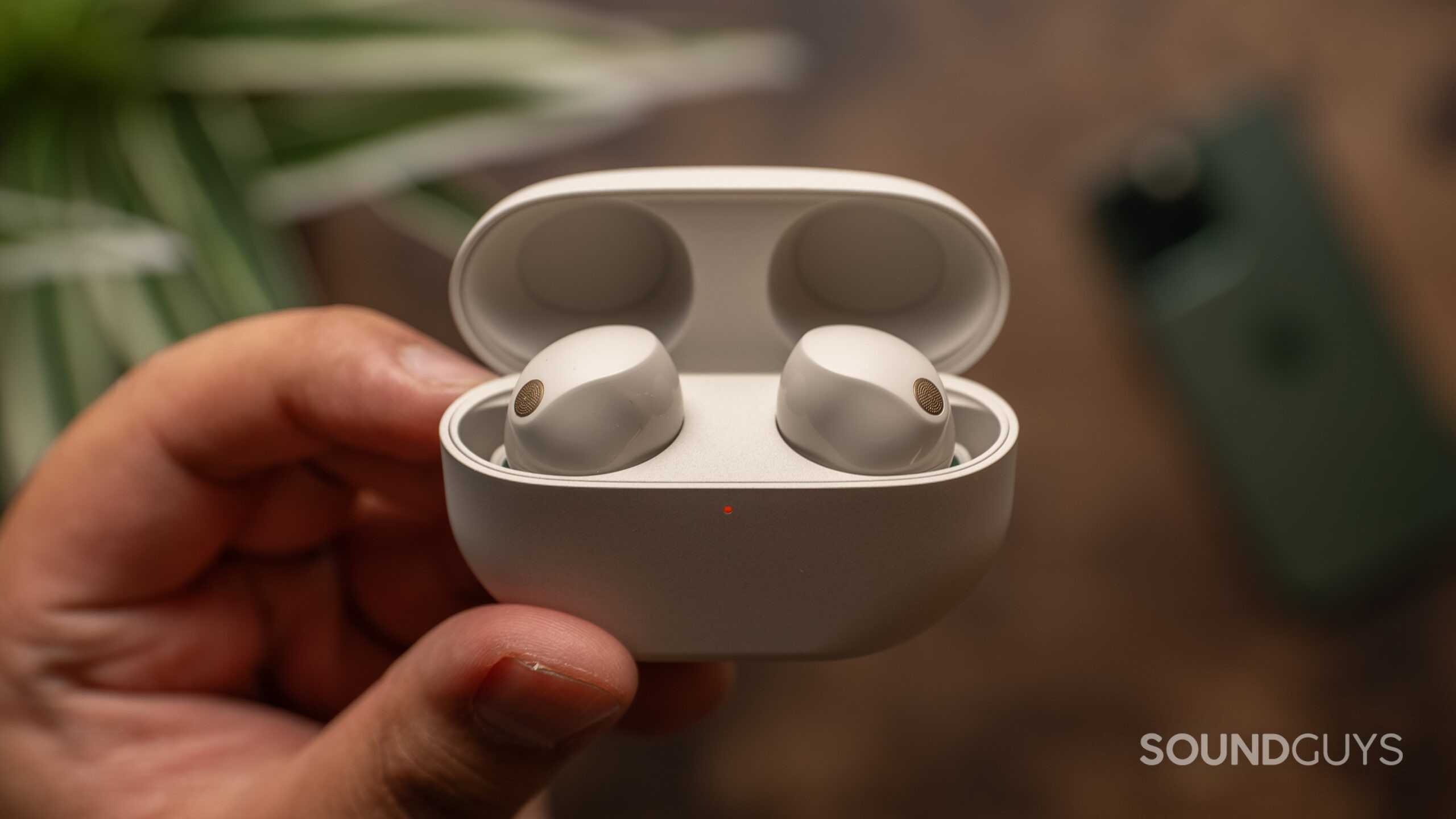
Reasons to Buy:
- Exceptional active noise cancelation
- Improved comfort and secure fit
- Excellent sound quality with customizable EQ
- Long battery life with fast charging
- Comprehensive app support
- Bluetooth Multipoint
Reasons Not to Buy:
- High price point ($299.99)
- Default sound may be too bass-heavy for some
- No aptX codec support
- Glossy finish on earbuds may feel slippery
The Sony WF-1000XM5 stands out as a top-tier choice in the competitive world of noise canceling earbuds. They are 25% smaller and 20% lighter than the previous WF-1000XM4, featuring a redesigned shape with more angled nozzles and flexible ear tips, of which you get four sets. All of which makes them a whole heck of a lot more comfortable and secure.
With a comfortable design, outstanding ANC, and fantastic battery life, the WF-1000XM5 are one of the best wireless earbuds on the market.
As for active noise cancelation (ANC), the WF-1000XM5 is one of the best in its class. Equipped with new processors and improved microphone systems, these earbuds effectively attenuate low-frequency noise by over 30 dB, resulting in an 87% reduction in perceived noise.
While the default sound profile leans towards a bass-heavy signature, the overall audio quality is excellent. The earbuds offer a wider soundstage and good clarity. Sony’s LDAC codec support also ensures high-quality audio streaming for compatible devices. Other features include customizable touch controls and multipoint connectivity. The Sony Headphones Connect app allows for extensive customization, including EQ adjustments and adaptive sound control.
Quick Specs
- Battery life: 9 hours and 32 minutes
- Fast charging: 3 minutes = 1 hour of playback
- Connectivity: Bluetooth 5.3 (SBC, AAC, LDAC, or LE Audio), Multipoint
- Protected against: Water resistant (IPX4)
- Weight: 6g per earbud


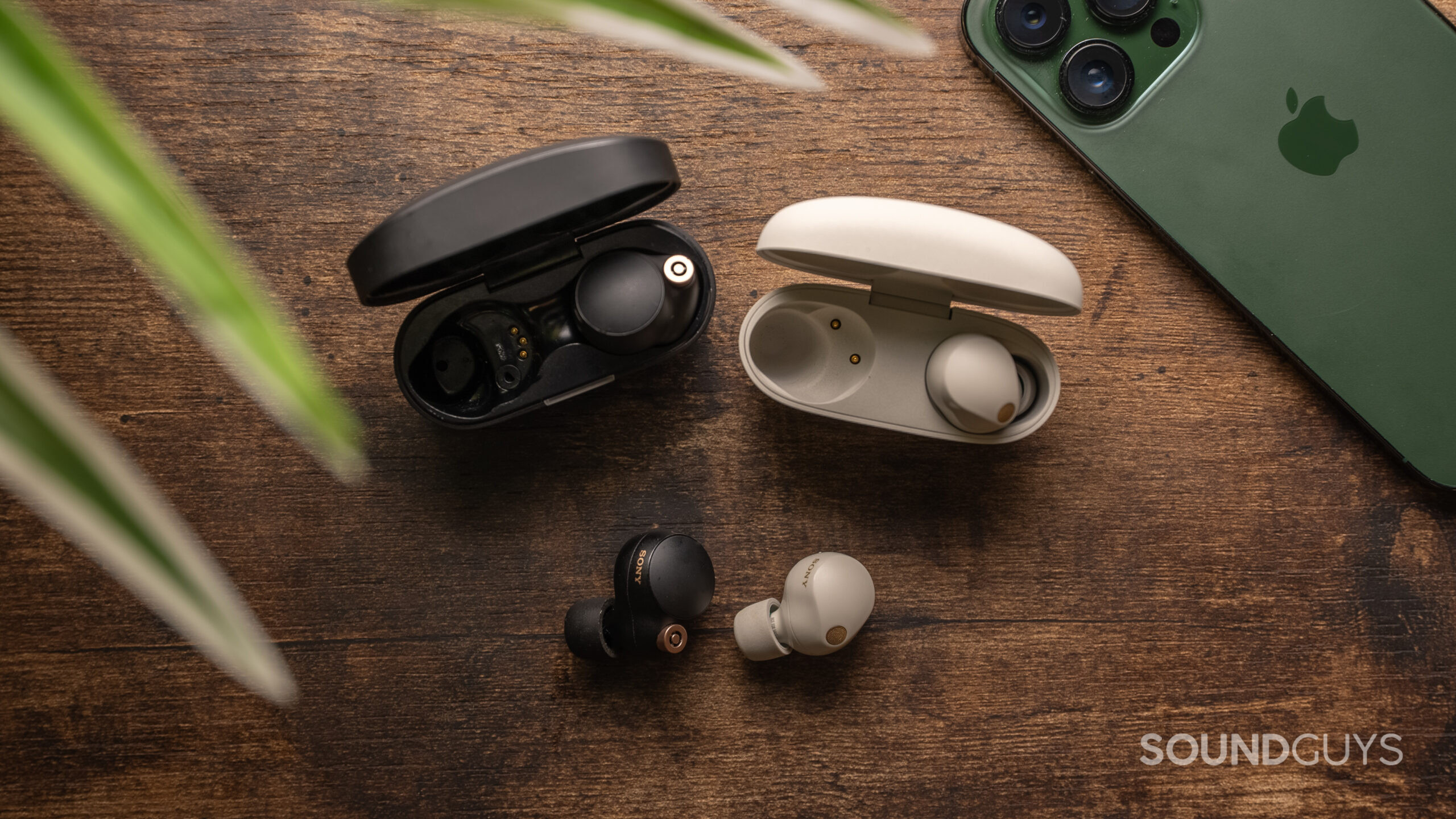
The decision to upgrade from the Sony WF-1000XM4 to the newer WF-1000XM5 really depends on your personal needs and preferences. In our detailed breakdown between the Sony WF-1000XM4 and WF-1000XM5, we found that the XM5 earbuds edge out the XM4 for ANC performance. However, if you’re looking for a significant upgrade in sound quality, you might not find it worth the additional cost, as the improvements in these areas aren’t substantial.
The WF-1000XM5 does offer improved comfort, with a design that fits more securely in the ear. If you’ve had issues with the WF-1000XM4 staying in your ears, this might be a compelling reason to consider the newer model.
That said, the WF-1000XM4 holds its own against modern flagships. The ANC and isolation are effective, and you get most of the same software features as the WF-1000XM5, making them the better bang for your buck.
Key Rating Metric
| SoundGuys Rating | 8.3 |
|---|---|
User Rating | 7.6 |
Sound Quality | 9.8 |
Isolation / Attenuation | 8.2 |
Active Noise Cancelling | 8.3 |
Objective Measurements
Loading chart ...
The default frequency response of the Sony WF-1000XM5 follows our preference curve fairly closely. There is a noticeable emphasis between 30-300Hz. This bump in bass and mid-bass frequencies explains why cellos, synth pads, and other bassy tones can sound more prominent than the ideal.
Sony equipped the WF-1000XM5 with two new processors: the Integrated Processor V2 and the HD Noise Canceling Processor QN2e to improve ANC performance. In combination, these allow the earbuds to process the signals from the six microphones (three on each bud). New dual feedback mics on the WF-1000XM5 are used to better monitor noise in the low frequencies.
Loading chart ...
According to our testing, the ANC attenuates over 30dB of low-frequency outside noise (below 1kHz), combined with impressive passive isolation. This makes the WF-1000XM5 a great companion for daily commuters, frequent flyers, or anyone working in a busy office or cafe. This all makes the Sony WF-1000XM5 a treat to use. During my morning commute, the earbuds do a good job blocking out the screeches and clatter of old subway cars, letting me tune out before I get dialed in for the working day.
The chart below shows how the sound of the Sony WF-1000XM5 was assessed by the Multi-Dimensional Audio Quality Score (MDAQS) algorithm from HEAD Acoustics.
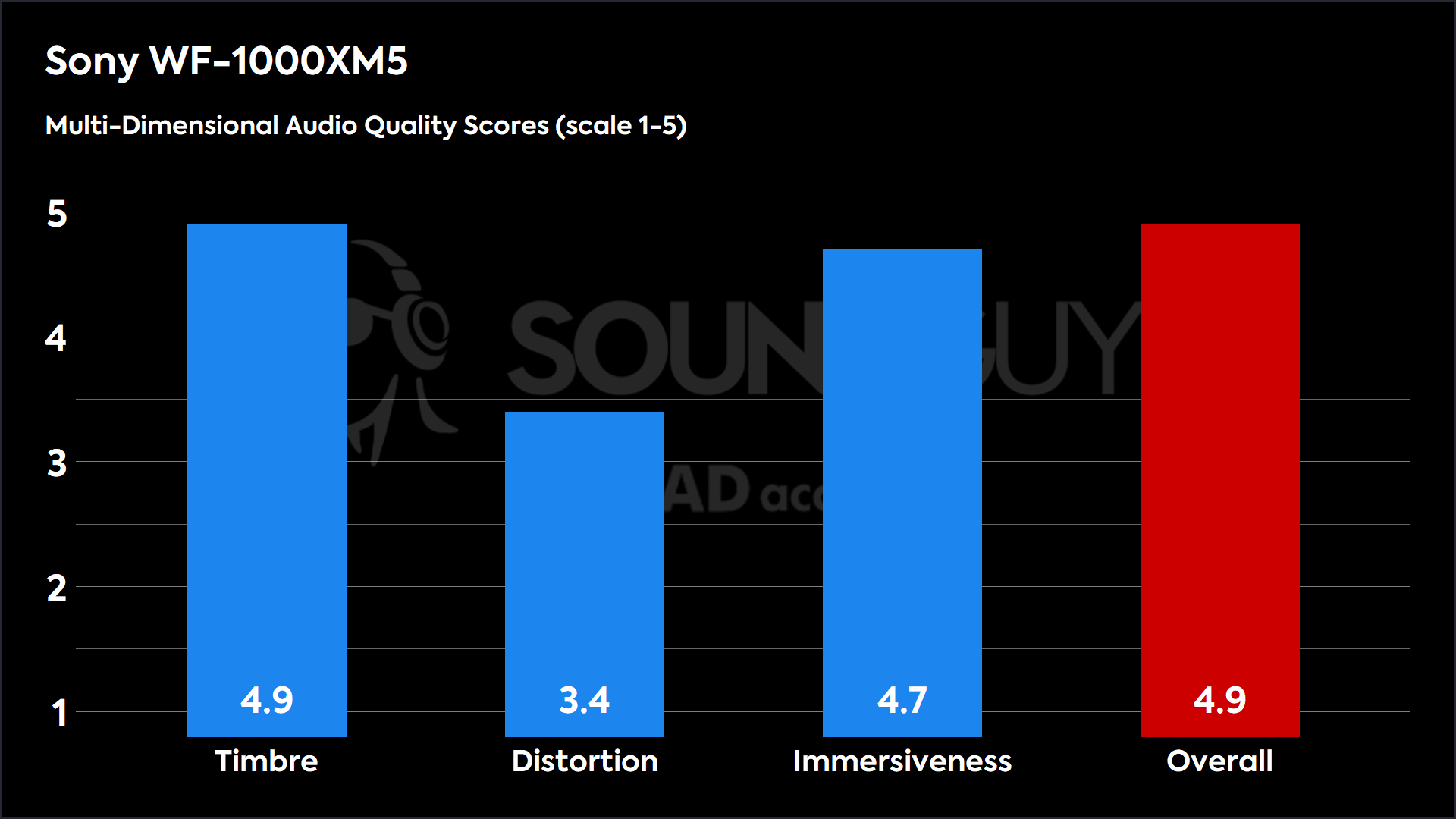
For most people, the sound of the Sony WF-1000XM5 will be pleasing, owing to its tuning and strong ability to maintain a convincing illusion of 3D space with a stereo image. Though you may notice distortion now and again, it doesn’t seem to rise to the level of being all that annoying to a virtual panel of hundreds of listeners. Overall, these earbuds post one of the highest overall MDAQS ratings we’ve come across, and it means there’s a high likelihood that you’ll like their sound.
Sony puts a lot of engineering effort into its microphone quality, though the Sony WF-1000XM5 mics don’t hold a candle to those of the over-ear WH-1000XM5. Take a listen to our standardized mic samples below.
Sony WH-1000XM5 mic demo (Ideal conditions):
Sony WH-1000XM5 mic demo (Office conditions):
Sony WH-1000XM5 mic demo (Street conditions):
Sony WH-1000XM5 mic demo (Windy conditions):
Best earbuds for iPhone owners: Apple AirPods Pro (2nd Gen)
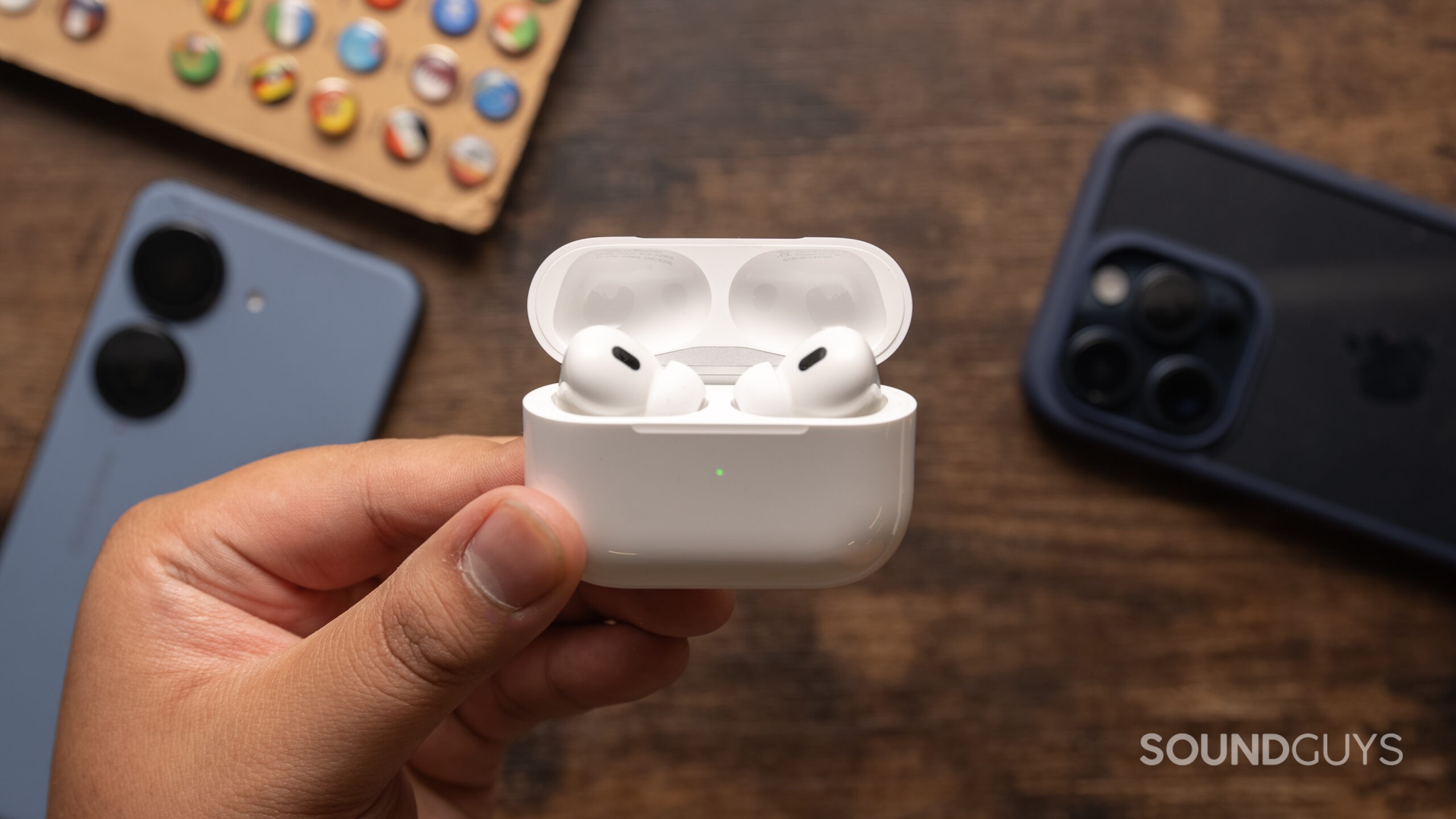
Reasons to Buy:
- Integration with Apple devices and exclusive features
- Strong ANC performance
- Good sound quality
- Personalized Spatial Audio support
- Case speaker for Find My
Reasons Not to Buy:
- Limited functionality with non-Apple devices
- No built-in EQ options
- Default sound profile may be too bass-heavy for some
- Mic performance can struggle in noisy environments
- No Bluetooth Multipoint
- No aptX codec support
- Battery life lags behind competitors
The Apple AirPods Pro (2nd Gen) is the premier choice for iPhone users. They seamlessly integrate with the Apple ecosystem and offer a slew of exclusive features, such as easy pairing, automatic switching between devices, and Adaptive Transparency mode. Thanks to the new H2 chip, the Active Noise Cancellation (ANC) performance is the best for AirPods so far. The AirPods Pro (2nd gen) effectively attenuates low-frequency noise by 20-30dB, translating to an 83% reduction in perceived noise.
If you own an iPhone, the latest AirPods Pro are the obvious choice.
Sound quality is excellent, with a slight emphasis on bass that most users will appreciate. The wider soundstage and good clarity across frequencies make for an enjoyable listening experience. The inclusion of personalized Spatial Audio and support for the AAC codec ensures high-fidelity audio for iOS devices. We do wish there was a customizable EQ in the Apple settings app, however.
Battery life has been improved, though it still lags behind the competitors. With ANC enabled, it offers over 6 hours of playback, and the case provides an additional 24 hours. The case now features a speaker for easier location tracking and supports MagSafe, Qi wireless, and Apple Watch charging.
If the $249 price tag is too steep for you, there are a handful of solid iPhone earbuds or AirPods Pro alternatives out there for iPhone and Android users alike. You can even snag the first-gen AirPods Pro for on the product's website.

Quick Specs
- Battery life: 5 hours and 43 minutes with ANC on (up to 30 hours total with the charging case)
- Connectivity: Bluetooth 5.3 with support for SBC and AAC codecs
- Protected against: IPX4 water resistance rating for both earbuds and case
- Weight: 5.3g per earbud
Key Rating Metric
| SoundGuys Rating | 7.6 |
|---|---|
User Rating | 7.5 |
Sound Quality | 9.6 |
Isolation / Attenuation | 6.0 |
Active Noise Cancelling | 8.3 |
Objective Measurements
Loading chart ...
Through the bass and mids, the AirPods Pro (2nd gen) closely follows our headphone preference curve and only makes significant deviations above 8kHz. Most listeners won’t be too bothered by the relative under-emphasis (compared to our preference curve) in the uppermost octave.
The chart below shows how the sound of the AirPods Pro (2nd Gen) was assessed by the Multi-Dimensional Audio Quality Score (MDAQS) algorithm from HEAD Acoustics.
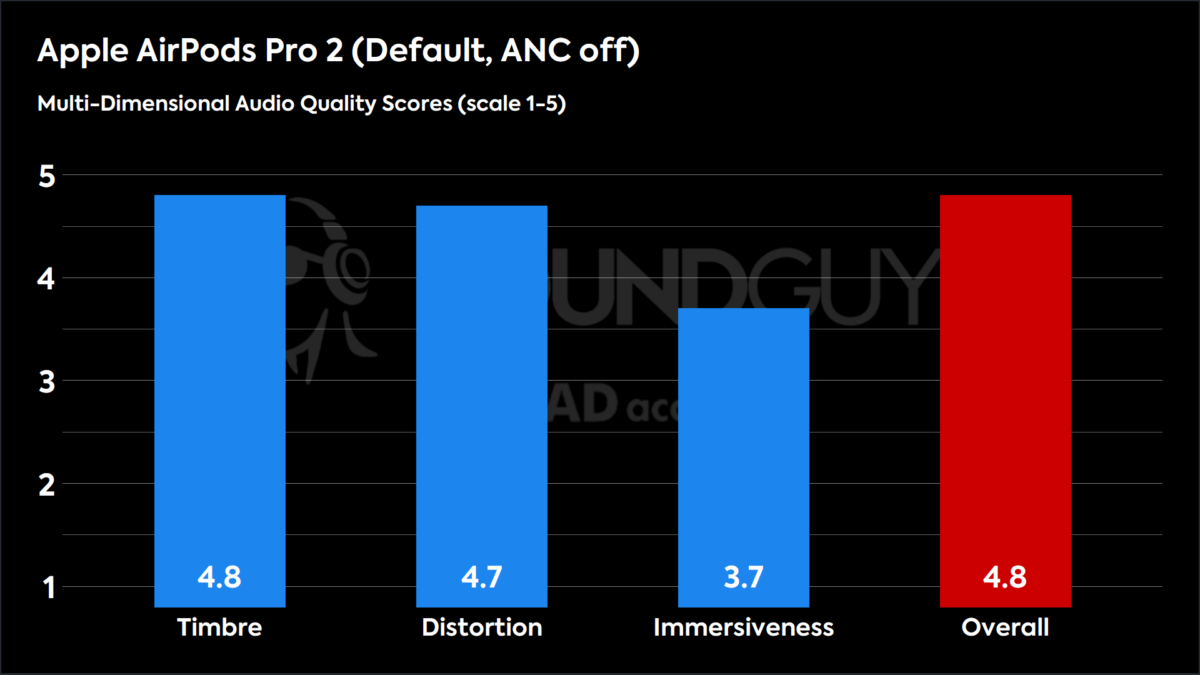
On the backs of super high timbre and distortion scores, the Apple AirPods Pro (2nd Generation) offers very high sound quality. Though the immersiveness score is merely “good,” when your weakest score is still relatively high, you’re in a solid spot.
Loading chart ...
Though the isolation is nothing to write home about, the ANC will destroy between 20-30dB of outside noise, depending on the frequency. That’s a respectable result for ANC earbuds, and this product should be well suited for commutes, air travel, or casual listening in a noisy environment.
The AirPods Pro’s mic system is very good for wireless earbuds, but its quality declines when there’s background noise. Take a listen to the various sample recordings below.
Apple AirPods Pro (2nd generation) microphone demo (Ideal conditions):
Apple AirPods Pro (2nd generation) microphone demo (Office conditions):
Apple AirPods Pro (2nd generation) microphone demo (Street conditions):
Apple AirPods Pro (2nd generation) microphone demo (Windy conditions):
The Jabra Elite 10 Gen 2 have the best active noise canceling
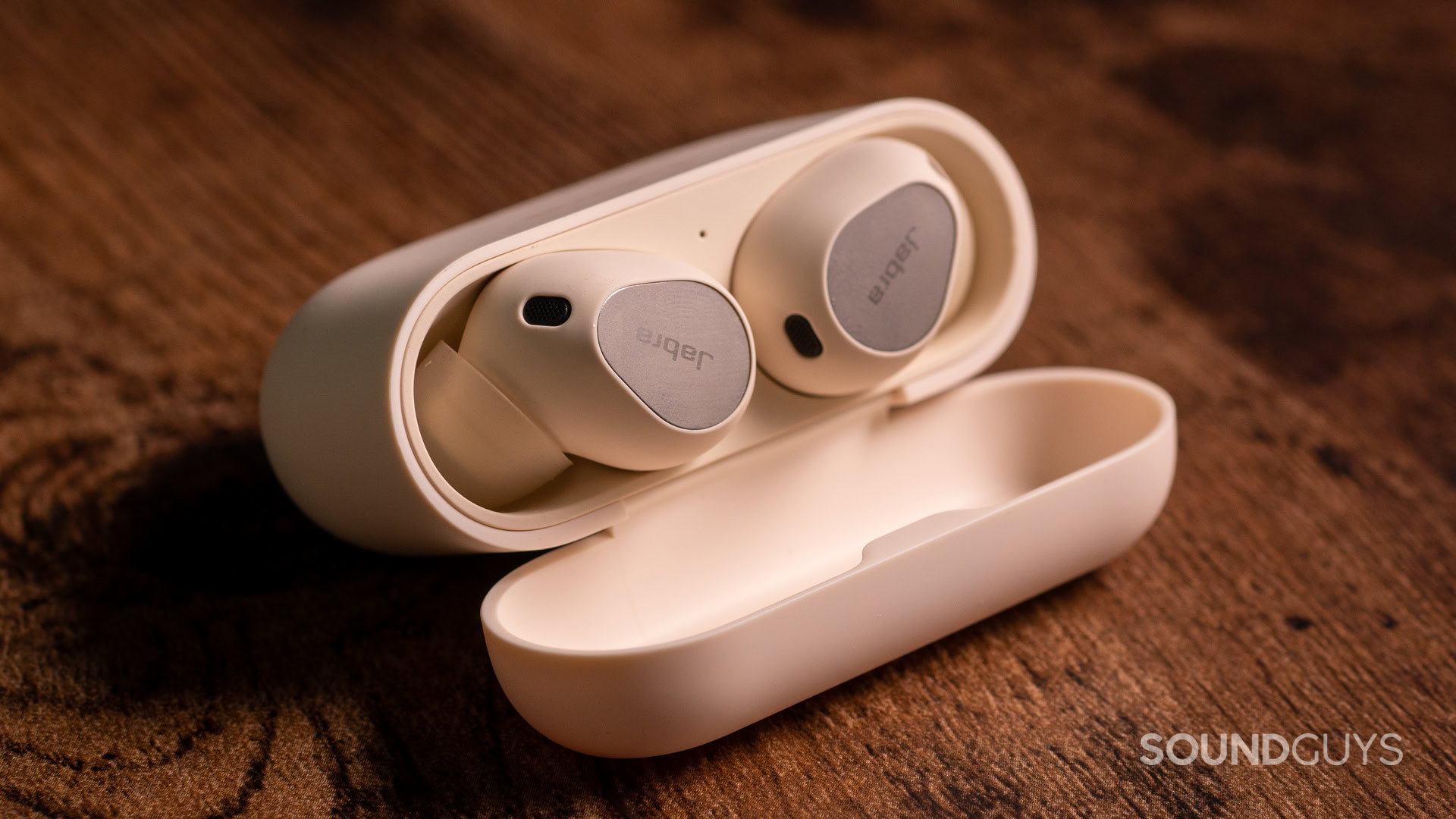
Reasons to Buy:
- Outstanding active noise cancelation (ANC)
- Excellent fit and comfort for long listening sessions
- Versatile connectivity options, including 3.5mm and USB-C wired connections
- Bluetooth Multipoint
- Comprehensive app with EQ customization
- Dolby Atmos with head tracking for Spatial Audio
- Can be used as sleep buds with white noise options
- High-quality microphone performance for calls
Reasons Not to Buy:
- Uncertain future for software updates
- Higher price point ($279.99)
- Shorter battery life compared to competitors (5.5 hours with ANC)
- Noticeable peak in high frequencies may be fatiguing for some listeners
- No aptX codec support
The Jabra Elite 10 Gen 2 sets a new standard for active noise cancelation in true wireless earbuds. With an impressive 85.1% noise reduction, they surpass the typical ceiling of 83% seen in most high-end models. This exceptional ANC performance makes them ideal for blocking out ambient noise in various environments.
The Jabra Elite 10 Gen 2 is for anyone who is looking for top-shelf ANC earbuds that can do it all, but aren’t constrained by cost.
These earbuds excel in comfort and fit, ensuring optimal performance for both the drivers and ANC. The unique design allows for an easy, secure fit in most ear shapes, which is crucial for maintaining consistent sound quality and noise cancelation. This comfort also enables extended listening sessions without fatigue. Versatility is another strength of the Elite 10 Gen 2, as it has the rare ability to connect to wired sources via the charging case. This feature makes it exceptionally adaptable for various listening scenarios, from mobile devices to in-flight entertainment systems.
While the sound quality has some quirks, particularly a peak in the high frequencies, overall audio performance is solid and can be adjusted using the companion app’s EQ settings. The earbuds also boast useful features like spatial audio with head tracking, multipoint connectivity, and a sleep mode with built-in white noise options.


Quick Specs
- Battery life: 5 hours and 27 minutes of playback with ANC on
- Connectivity: Bluetooth 5.3 with support for SBC, AAC, and LC3 codecs; can also connect to wired sources via 3.5mm or USB-C using the charging case as a transmitter
- Protected against: IP57 water and dust resistance
- Weight: 5.6g per earbud
Key Rating Metrics
| SoundGuys Rating | 8.0 |
|---|---|
User Rating | 8.2 |
Sound Quality | 8.4 |
Isolation / Attenuation | 6.3 |
Active Noise Cancelling | 8.5 |
Objective Measurements
Loading chart ...
The response of the Jabra Elite 10 Gen 2 is a little bit odd, but not odd in the way that would be off-putting to most. The first deviation from our preference curve, the dip from 100 to 200Hz, will make some vocals a little softer than they should — making bass comparatively louder. However, it’s that peak at 7.2kHz that gets a bit grating over time. Because it’s so high, most people will perceive this as increased “detail” or room effects.
The chart below shows how the sound of the Jabra Elite 10 Gen 2 was assessed by the Multi-Dimensional Audio Quality Score (MDAQS) algorithm from HEAD acoustics.
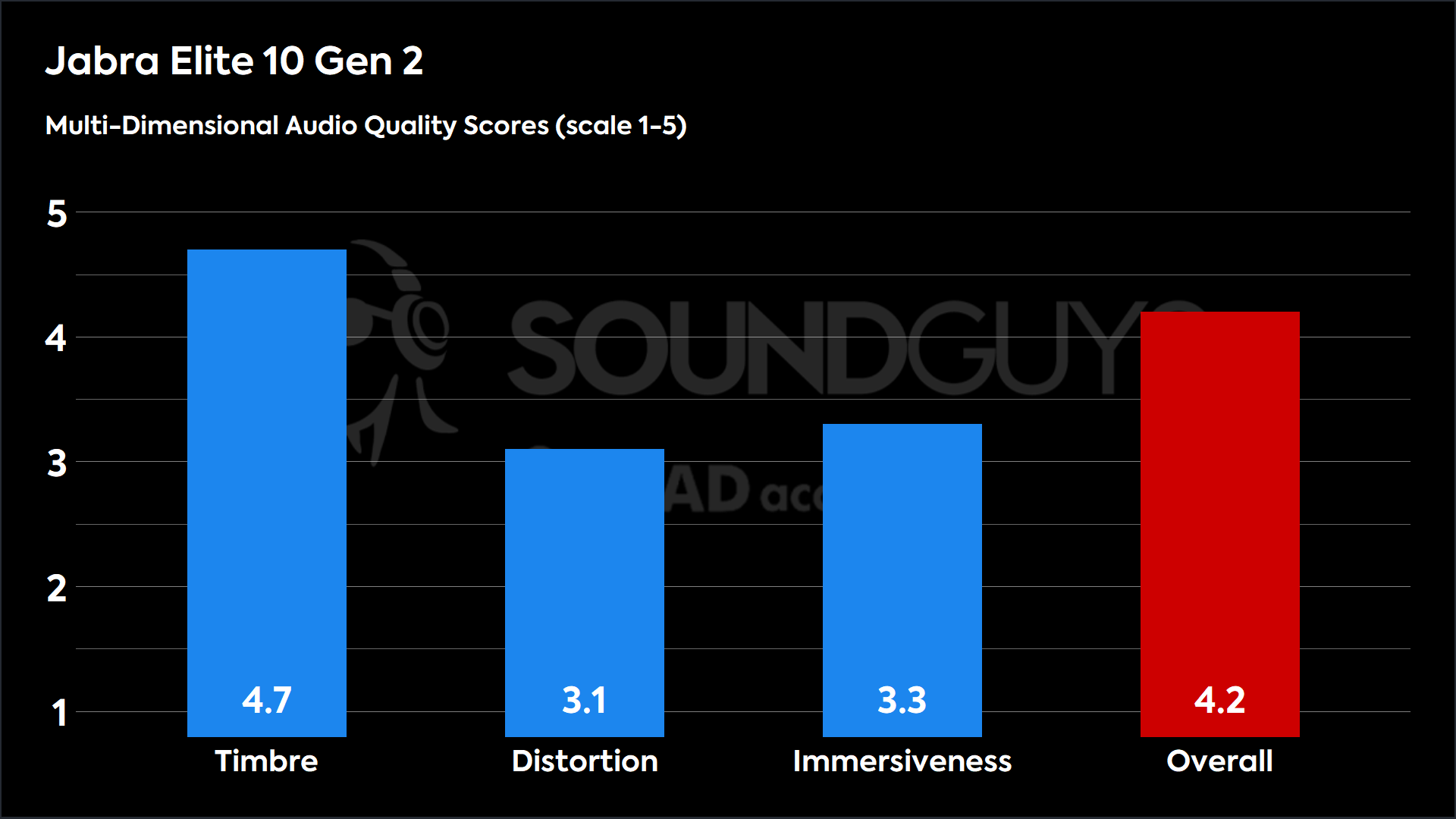
A simulated panel of listeners rates the performance of the Jabra Elite 10 Gen 2 fairly highly, though it’s not as high of a score as one might expect. Though the timbre is well-rated, the distortion and immersiveness scores are quite low.
Jabra made its name on professional headsets, and no surprise: the Jabra Elite 10 Gen 2 is absolutely loaded for this task with a 6-mic array. Below are samples we’ve collected in our lab.
Jabra Elite 10 Gen 2 microphone demo (Ideal conditions):
Jabra Elite 10 Gen 2 microphone demo (Office conditions):
Jabra Elite 10 Gen 2 microphone demo (Street conditions):
Jabra Elite 10 Gen 2 microphone demo (Windy conditions):
Best features on wireless earbuds: JBL Tour Pro 3
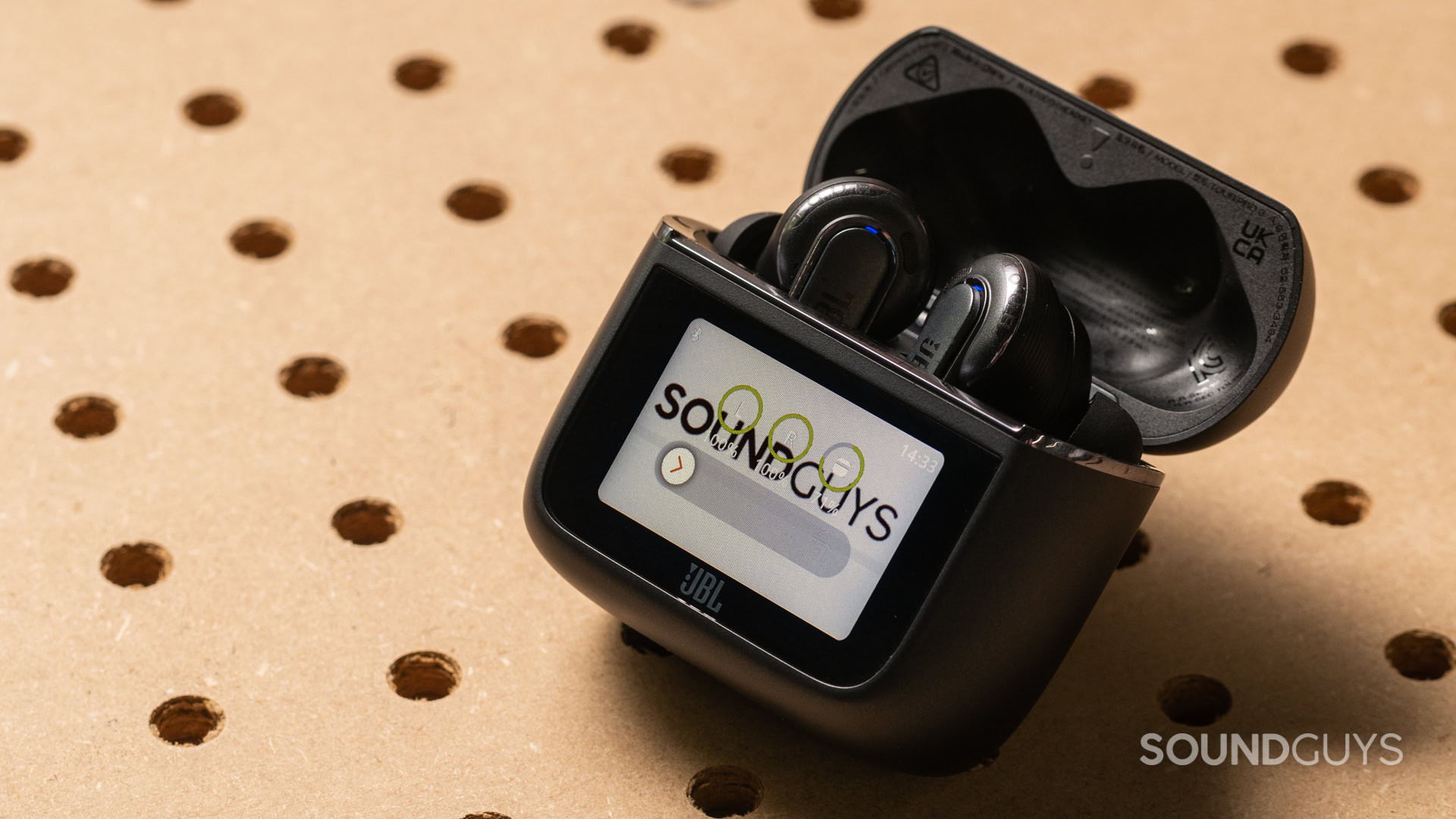
Reasons to Buy:
- Innovative Smart Charging Case with a touchscreen display
- Excellent sound quality with customizable EQ
- Comprehensive connectivity options
- Strong noise cancelation and effective transparency mode
- Auracast feature for audio sharing
- Impressive microphone performance for calls
- Long battery life
Reasons Not to Buy:
- Short nozzles may lead to fit issues for some users
- The default sound signature may be too bass-heavy for some listeners
- Firmware updates can be time-consuming
- Touch controls are not fully customizable
The JBL Tour Pro 3 represents a significant leap forward in wireless earbud technology. The standout feature is its Smart Charging Case, which boasts a touchscreen display for easy access to functions like ANC control, EQ settings, and even acts as an audio transmitter for wired sources.
The sound of the JBL Tour Pro 3 is definitively geared toward a more consumer-friendly audience. The earbuds support multiple codecs, including LDAC and LC3, ensuring high-quality audio streaming. While the default sound signature has a slight bass emphasis, the 10-band EQ in the app allows for precise customization.
Due to the large size of the earbuds, comfort may vary, but multiple ear tip options are provided. The Active Noise Cancellation (ANC) performs very well, quieting about 83-84% of outside noise.
Overall, the JBL Tour Pro 3 offers a feature-rich package that’s hard to beat, making it an excellent choice for tech enthusiasts who want the most advanced and future-proof earbuds available.

Quick Specs
- Battery life: 8 hours 17 minutes (with ANC)
- Connectivity: Bluetooth 5.4 (SBC, AAC, LDAC, LC3)
- Water resistance: IP55
- Weight: 5.6g per earbud
Key Rating Metric
| SoundGuys Rating | 8.6 |
|---|---|
User Rating | 7.1 |
Sound Quality | 9.8 |
Isolation | 7.1 |
Active Noise Cancelation | 8.4 |
Objective Measurements
Loading chart ...
The bass bump will likely appeal to most listeners, as there are plenty out there that like a little more low-end — especially when there’s such an emphasis on the highs as well.
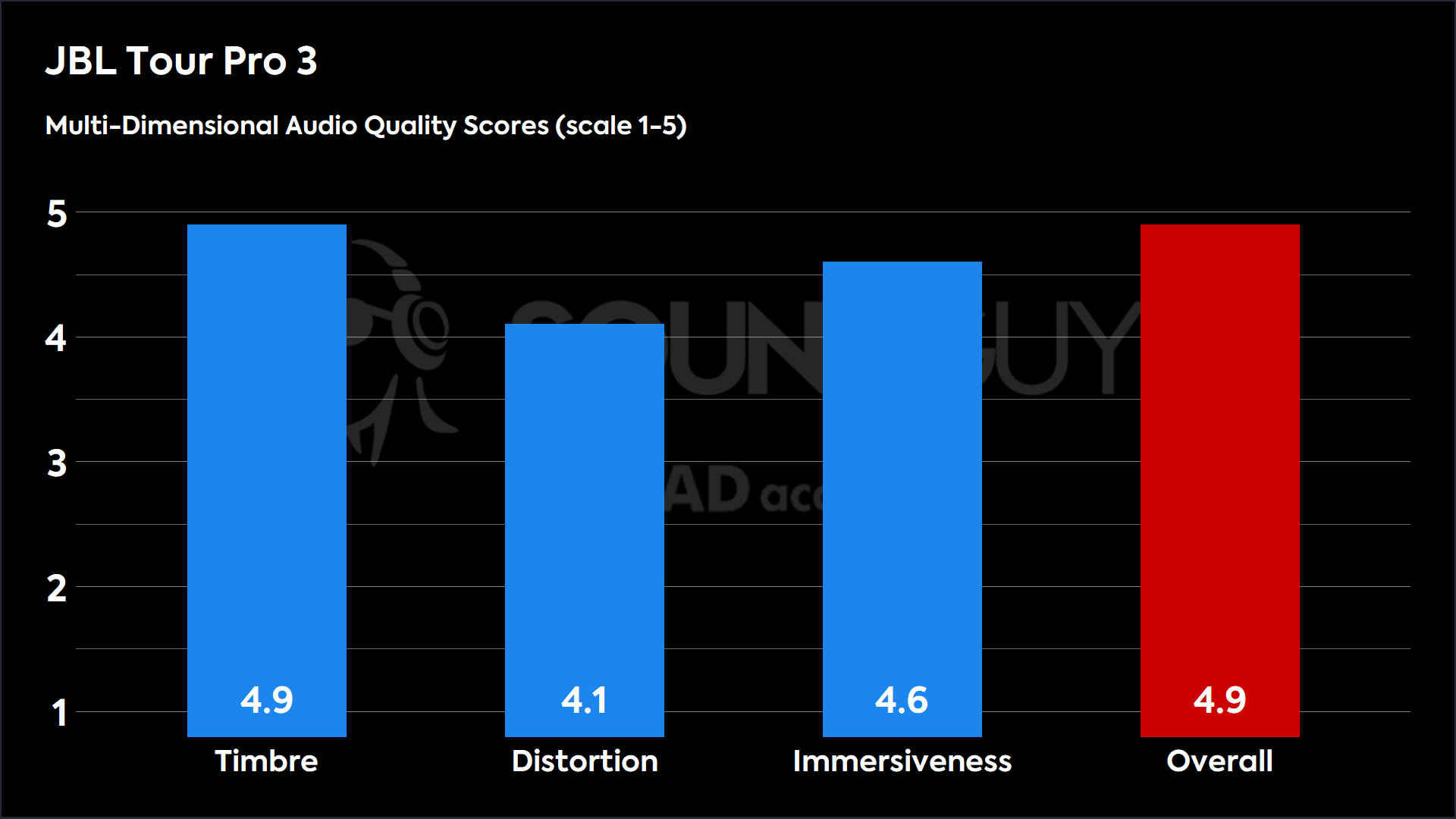
Our virtual panel of listeners has spoken, and the JBL Tour Pro 3 sounds the way most people want true wireless earbuds to sound.
Loading chart ...
With the ANC enabled and set to full-blast, you can assume about 83-84% of outside noise to be hushed away.
Best wireless earbuds under $200: JBL Live Beam 3
Reasons to Buy:
- Excellent sound quality
- Feature-packed, including a smart case with a display
- Comfortable
- Comprehensive app with EQ presets and customization options
- Bluetooth Multipoint
- Effective microphone performance for calls
Reasons Not to Buy:
- Active Noise Cancellation (ANC) performance is not top-tier
- Short nozzles may lead to fit issues for some users
- Default sound signature may be too bass-heavy for some listeners
- Firmware updates can be time-consuming
- Touch controls are not fully customizable
If you’re looking for similar products to the JBL Tour Pro 3, the list begins and ends with the JBL Live Beam 3. Though these earbuds aren’t as expensive as the JBL Tour Pro 3, they pack in many of the same features as the newer model — with the glaring exception of the audio transmitter.
Sound quality is a strong point, and the earbuds support multiple codecs, including LDAC, for high-quality streaming. While the default sound signature leans towards a bass-heavy profile, EQ presets in the app allow for customization to suit different preferences.
Comfort is generally good, though the short nozzles may present fit issues for some users. The IP55 rating ensures durability against dust and water splashes, making these suitable for workouts and daily use. While the Active Noise Cancellation (ANC) is decent, it’s not class-leading.
Overall, these earbuds offer a compelling package for the price for tech enthusiasts who appreciate a feature-rich product and don’t mind relying on an app for full functionality.


Quick Specs
- Battery life: 8 hours 14 minutes
- Connectivity: Bluetooth 5.3 (SBC, AAC, LDAC, LC3)
- Water resistance: IP55
- Weight: 4.9g per earbud
Key Rating Metric
| SoundGuys Rating | 8.1 |
|---|---|
User Rating | 10 |
Sound Quality | 9.8 |
Isolation / Attenuation | 5.7 |
Active Noise Cancelling | 7.5 |
Objective Measurements
Loading chart ...
The JBL Live Beam 3’s sound is characterized by strong bass, emphasized highs, and some odd things going on in the upper bass. Though this is very much a consumer-friendly sound, it’s not exactly what you want for critical listening — which is not a problem for anyone looking at these earbuds. It also has an interesting drop in the highs that diverges with our preference curve, but it doesn’t impact most peoples’ music all that much.
The chart below shows how the sound of the JBL Live Beam 3 was assessed by the Multi-Dimensional Audio Quality Score (MDAQS) algorithm from HEAD acoustics.
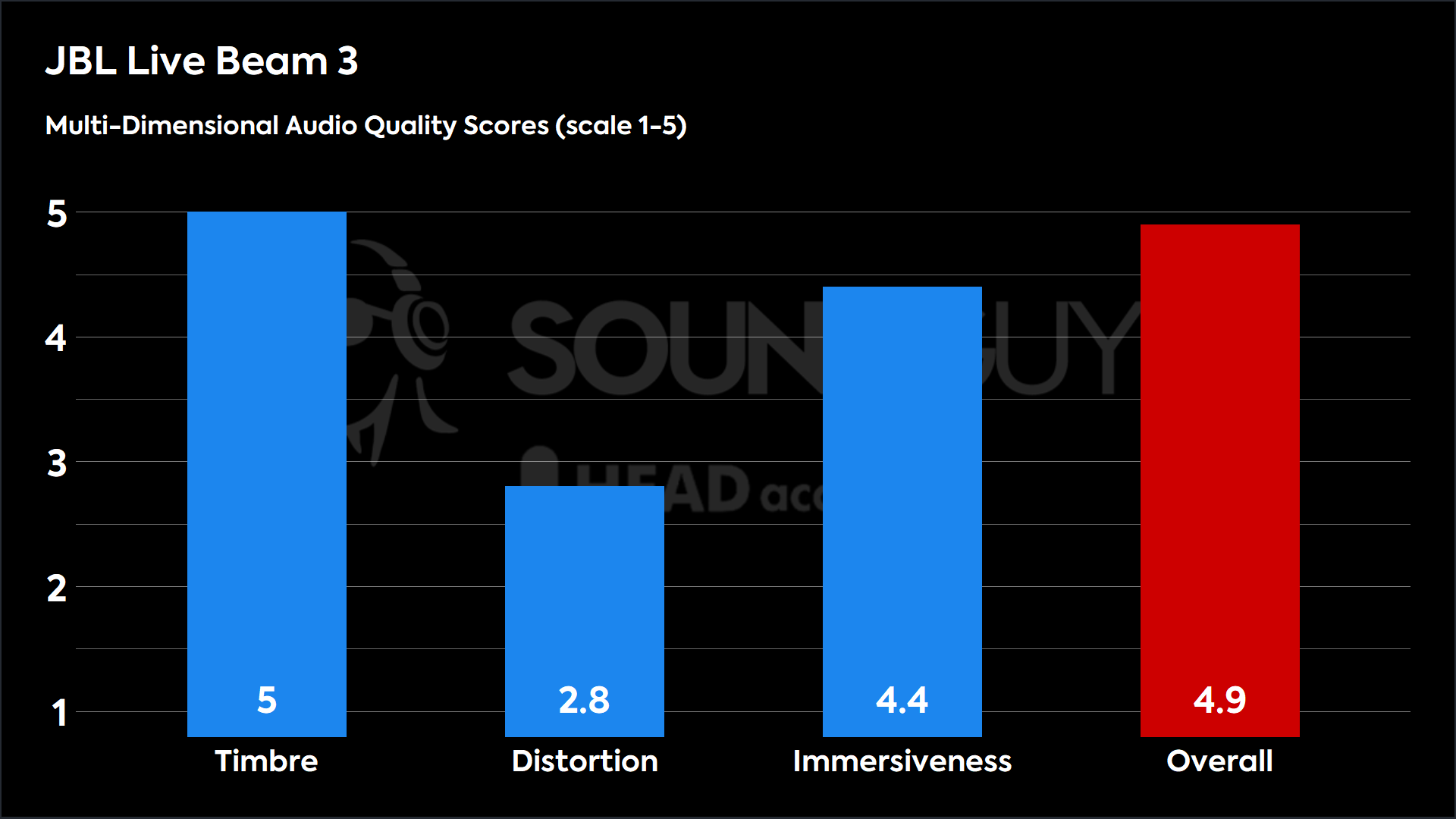
With the highest rating you can earn for Timbre and a “merely” excellent score for immersiveness, the overall score is predictably dragged to a very respectable spot. This simply means that a simulated panel of listeners would rate the JBL Live Beam 3 very well in terms of sound quality.
As the JBL Live Beam 3 is a set of earbuds meant to go with you everywhere, it’s no surprise that they have a mic array that will allow you to handle phone calls. Take a listen below:
JBL Live Beam 3 microphone demo (Ideal conditions):
JBL Live Beam 3 microphone demo (Office conditions):
JBL Live Beam 3 microphone demo (Street conditions):
JBL Live Beam 3 microphone demo (Windy conditions):
Best wireless earbuds under $150: Nothing Ear
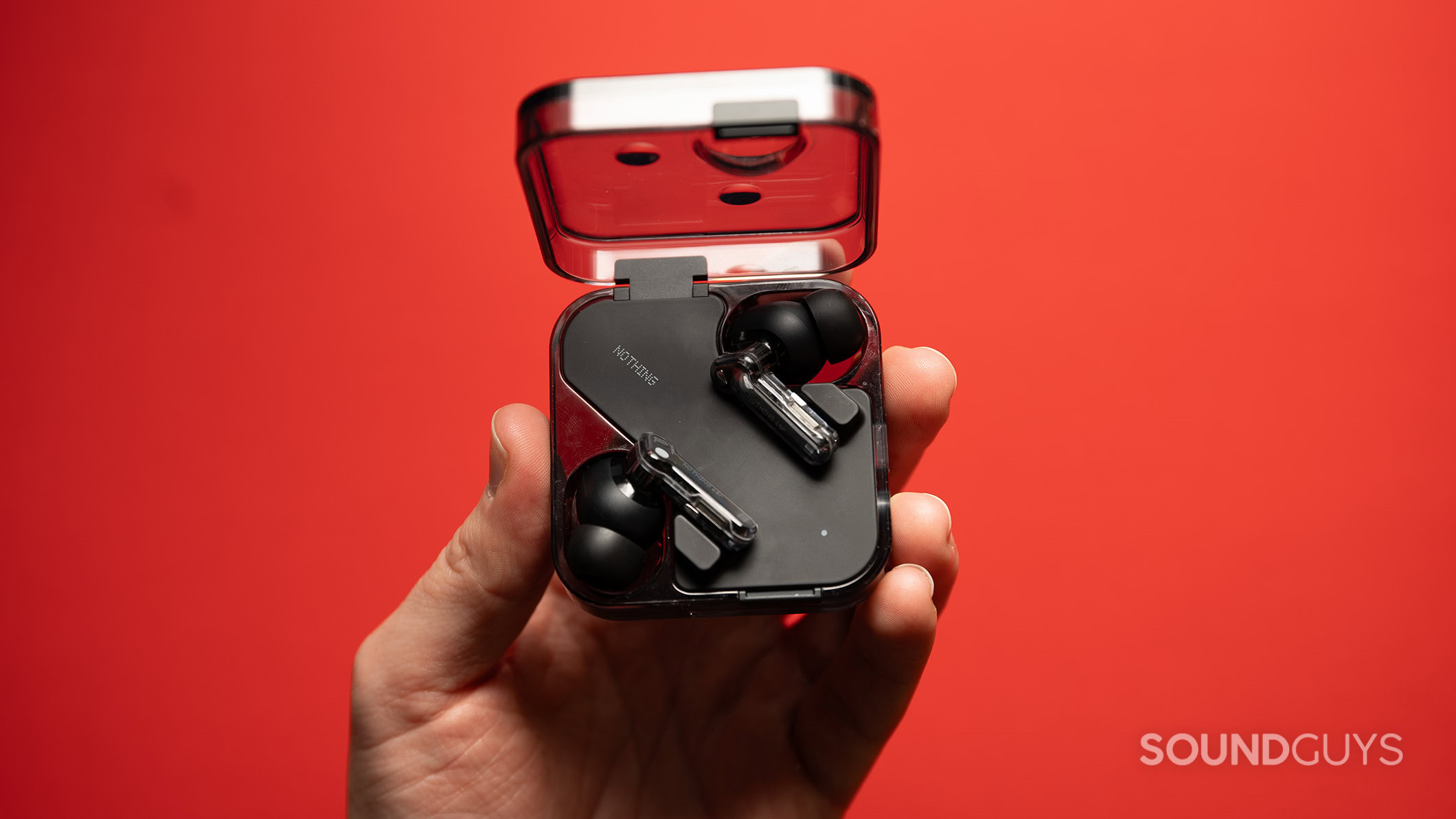
Reasons to Buy:
- Excellent sound quality with highly customizable EQ
- Comfortable and lightweight
- Competitive price ($149)
- Effective microphone system for calls
- IP54/IP55 water and dust resistance
Reasons Not to Buy:
- Not the best ANC, and affects sound quality when enabled
- Some connection issues reported in busy areas with Bluetooth interference
- Bass-heavy default sound profile may not suit all listeners
The Nothing Ear is one of the best-value buys for true wireless earbuds. Despite their affordable $149 price tag, these earbuds pack in an impressive array of features that rival much pricier models.
For audio quality, the Nothing Ear shines with great sound clarity and an immersive soundstage thanks to its 11mm ceramic drivers. An advanced parametric EQ allows you to precisely tune the sound to your preferences. It also supports high-quality LDAC and LHDC codecs for lossless wireless audio.
These earbuds are packed full of features that will please casual listeners and audiophiles alike.
The earbuds are super comfortable and lightweight. They have a strong transparency mode and outstanding noise rejection for the microphones. Battery life is solid at around 8 hours per charge, with quick USB-C and wireless charging available. Other helpful features include customizable touch controls, wear-detection sensors, and low-latency gaming modes. The companion app is easy to use and packed with customization options.
While the ANC could be stronger, the Nothing Ear’s overall performance and feature set make it an incredible value in the wireless earbud market. You get premium features and sound quality at a much lower price than flagship competitors.


Quick Specs
- Battery life: 8 hours and 4 minutes of playback (up to 40 hours total with the charging case)
- Connectivity: Bluetooth 5.3 with support for LHDC 5.0, LDAC, AAC, and SBC codecs
- Protected against: IP54 rating for earbuds, IP55 for the charging case
- Weight: 4.6g per earbud
Key Rating Metric
| SoundGuys Rating | 8.1 |
|---|---|
User Rating | 8.4 |
Sound Quality | 9.8 |
Isolation / Attenuation | 5.5 |
Active Noise Cancelling | 7.1 |
Objective Measurements
Loading chart ...
As you can see in the chart above, the Nothing Ear has a default frequency response that amplifies low frequencies above our headphone preference curve. There is also a drop in output around 470Hz and a boost around 5.5kHz compared to our preference. You can easily equalize these variances using the advanced equalizer.
The chart below shows how the sound of the Nothing Ear was assessed by the Multi-Dimensional Audio Quality Score (MDAQS) algorithm from HEAD acoustics.
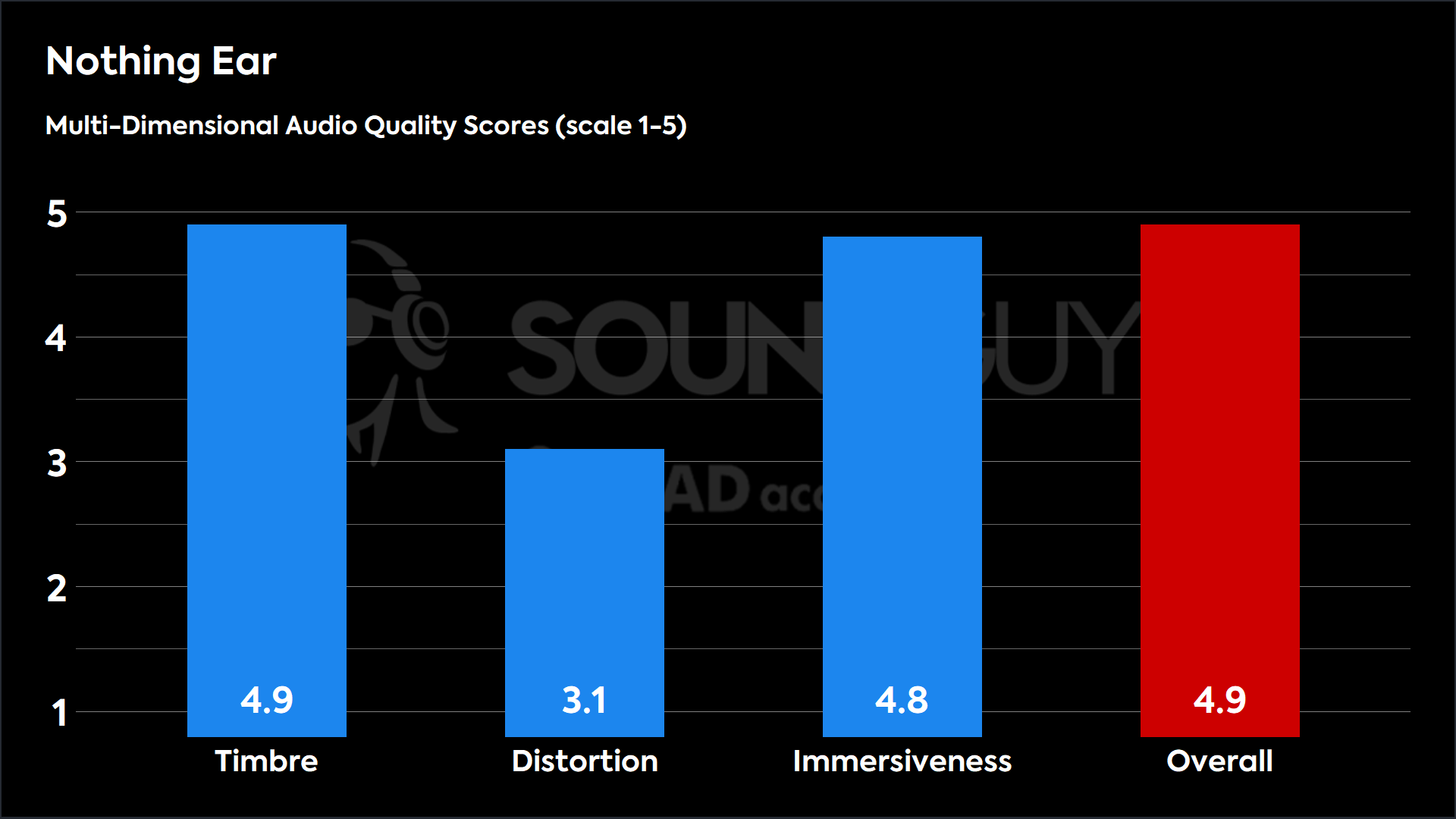
A simulated panel of listeners rates the Nothing Ear very highly in Timbre and Immersiveness. An Overall score of 4.9 is among the highest of the earbuds we’ve tested. Most people will like the way the Nothing Ear sounds straight out of the box.
Loading chart ...
While Nothing promises 45dB of noise attenuation extending up to 5kHz, we aren’t seeing those results in our testing lab. Our testing shows about 20dB of attenuation from the ANC in the low frequencies and then about 30dB of total attenuation in the high frequencies from passive isolation. This reduces the loudness of most sounds by around 75%.
he Nothing Ear has three mics and an AI noise reduction algorithm to suppress background noise. While voices sound slightly muffled, the background noise reduction algorithm is one of the best we’ve heard. No matter where you are, the person on the other end of the line should still be able to understand what you are saying.
Nothing Ear microphone demo (Ideal conditions):
Nothing Ear microphone demo (Office conditions):
Nothing Ear microphone demo (Street conditions):
Nothing Ear microphone demo (Windy conditions):
Best wireless earbuds under $130: Anker Soundcore Liberty 4 Pro
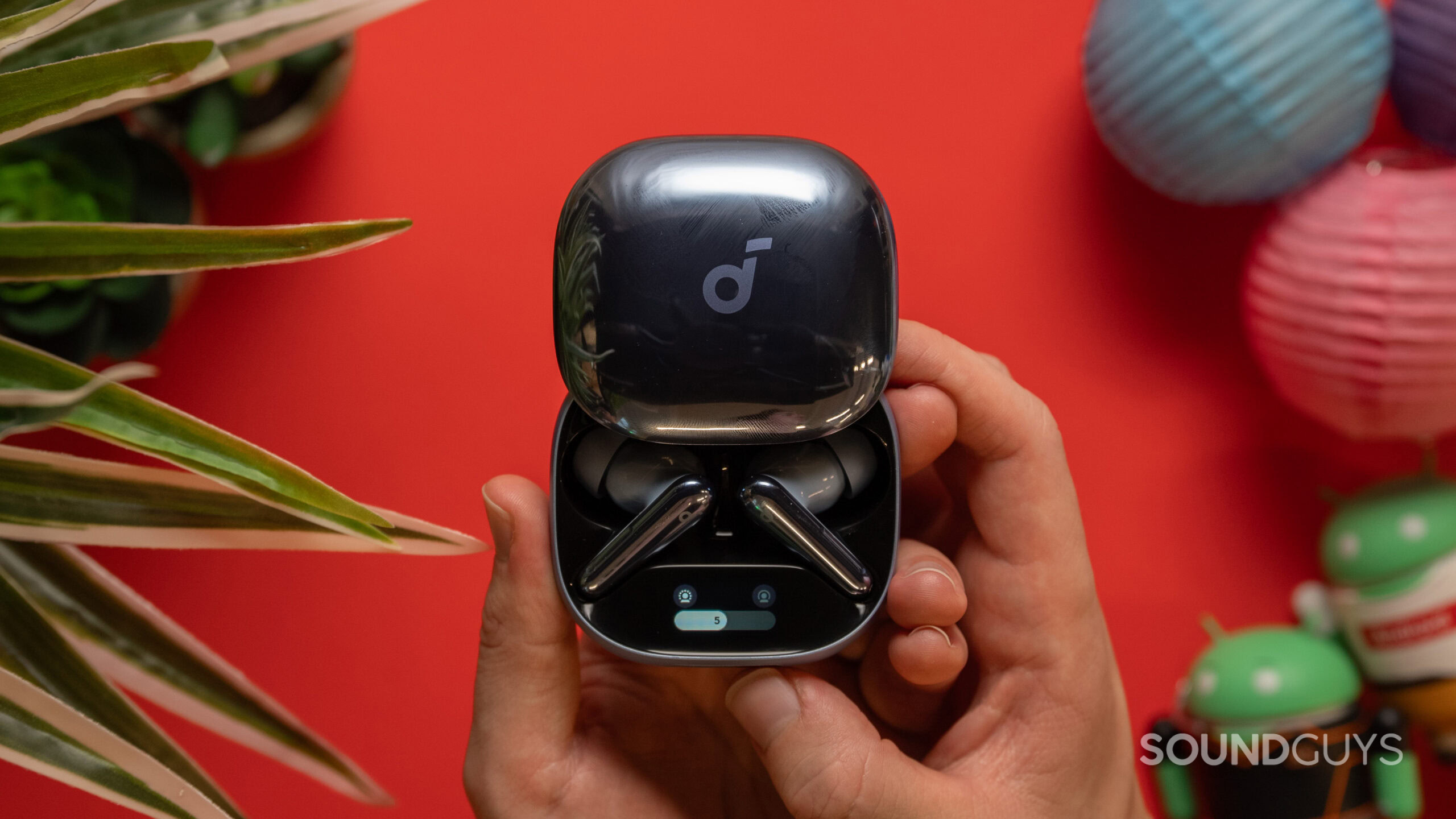
Reasons to Buy:
- Value for money
- Comprehensive feature set
- Good sound quality with customizable EQ
- Effective noise cancelation
- Bluetooth 5.4 with LDAC support
- Impressive microphone performance
- Fast charging capability
Reasons Not to Buy:
- Charging case is somewhat gimmicky
- Case is prone to fingerprints
- Spatial audio performance is underwhelming
- App requires account creation
The Anker Soundcore Liberty 4 Pro offers an impressive array of features typically found in more expensive models. Its standout feature is the unique charging case with a small display and touch controls, allowing quick adjustments to ANC and other settings. While innovative, this feature may be more novel than practical for some users.
Sound quality is a strong point, closely following preferred frequency responses with a slight emphasis on bass. The companion app provides extensive customization options, including a variety of EQ presets and an eight-band custom equalizer. Noise cancelation performs well, reducing low-frequency noise by about 30dB, making it effective for urban environments.
Comfort is generally good, with multiple ear tip sizes provided and an in-app fit test. While the spatial audio feature is included, its performance is not particularly impressive.
Overall, the Anker Soundcore Liberty 4 Pro offers exceptional value. It provides premium features and solid performance at a mid-range price point, making it an excellent choice for budget-conscious buyers seeking high-end functionality.

Quick Specs
- Battery life: 7.5 hours (with ANC), up to 30 hours with case
- Connectivity: Bluetooth 5.4 (SBC, AAC, LDAC)
- Water resistance: IPX5
- Weight: 5.5g per earbud, 51g case
Objective Measurements
Loading chart ...
The default sound of the Anker Soundcore Liberty 4 Pro closely follows our headphone preference curve. The Liberty 4 Pro have more of an emphasis on bass frequencies below 200Hz. Those who love thumping bass will enjoy this, while others can easily remedy it using the custom equalizer. Across the mids and highs, the Liberty 4 Pro follow our curve quite closely.
Loading chart ...
Our testing shows that the ANC reduces low-frequency noise, such as the rumble of an airplane engine, by about 30 dB. In real-world use, I found the Anker Soundcore Liberty 4 Pro does a great job of blocking out the sounds of a noisy city.
Best wireless earbuds under $100: EarFun Air Pro 4
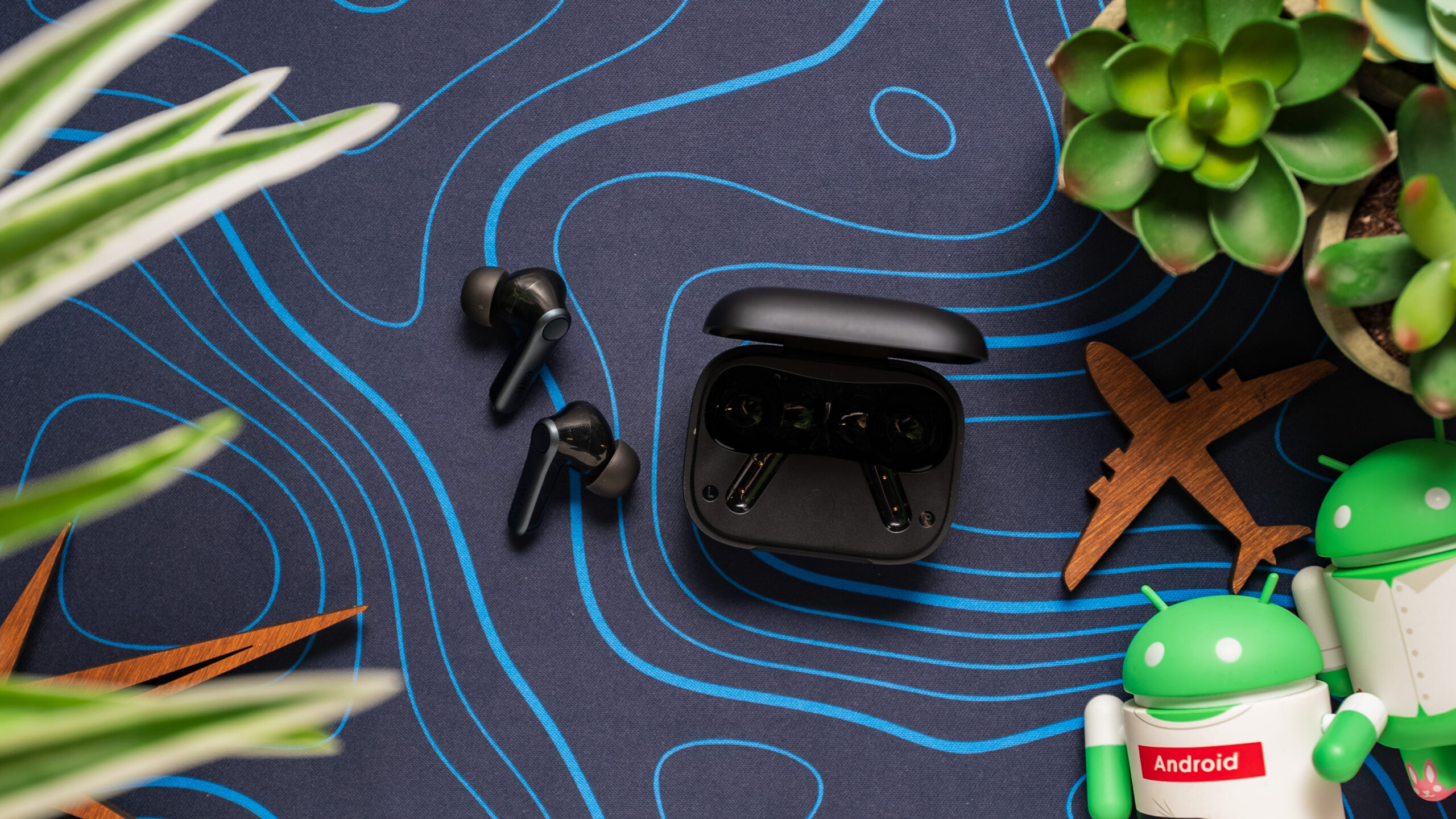
Reasons to Buy:
- Excellent sound quality with customizable EQ
- Strong active noise cancelation (ANC) with multiple modes
- Impressive battery life
- Comprehensive app with extensive features
- IPX5 water resistance rating
- Bluetooth 5.4 with LDAC, aptX, AAC, and SBC support
- Bluetooth multipoint and Google Fast Pair
- Wireless charging case
Reasons Not to Buy:
- ANC impacts sound quality when turned off
- Microphone performance struggles in noisy environments
- Default tap controls may need customization
The EarFun Air Pro 4 offer an impressive array of features typically found on much more expensive earbuds. With an IPX5 rating, long battery life, and effective ANC with multiple modes, including adaptive options, these earbuds punch well above their weight class in terms of functionality.
Anyone seeking feature-packed earbuds that don't break the bank will find a lot to love with the EarFun Air Pro 4.
The EarFun Audio app provides extensive customization options, including 30 EQ presets and a 10-band custom equalizer. The Air Pro 4 boasts Bluetooth 5.4 with support for high-quality codecs like LDAC and aptX, ensuring excellent audio quality for Android and iOS users. It also supports Bluetooth multipoint for seamless switching between devices.
For most people, the EarFun Air Pro 4 represents exceptional value. It excels in key areas like sound quality, noise cancellation, and battery life while offering premium features such as wireless charging and advanced codec support.

Quick Specs
- Battery life: 8 hours and 44 minutes (up to 41 hours total with the charging case)
- Connectivity: Bluetooth 5.4 with support for LDAC, aptX, AAC, and SBC codecs
- Protected against: IPX5 water resistance rating
- Weight: 5g per earbud
Key Rating Metric
| SoundGuys Rating | 8.4 |
|---|---|
Sound Quality | 9.6 |
Isolation / Attenuation | 5.7 |
Active Noise Cancelling | 7.5 |
Objective Measurements
Loading chart ...
The frequency response of the EarFun Air Pro 4 closely follows our headphone preference curve, aside from a dip in the highs around 8-11kHz. If you find that cymbals and other high-frequency sounds are too quiet for your liking, try boosting the 8khz slider in the custom equalizer in the app.
The chart below shows how the sound of the EarFun Air Pro 4 was assessed by the Multi-Dimensional Audio Quality Score (MDAQS) algorithm from HEAD acoustics.
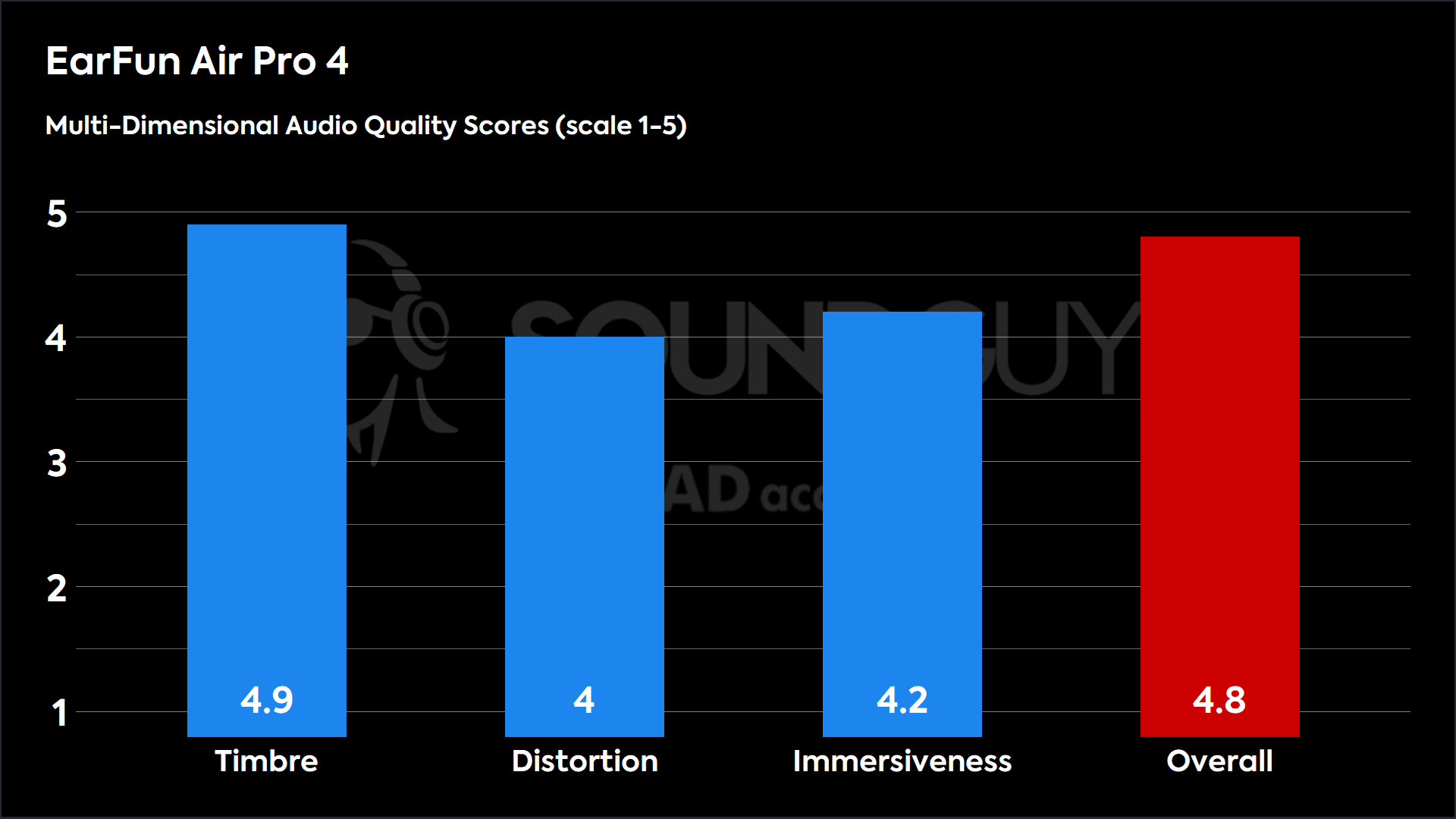
While the EarFun Air Pro 3 struggled with distortion, that’s not the case here. The EarFun Air Pro 4 achieve great scores across the board from a simulated panel of listeners. This means there is a high chance that you will enjoy the sound quality of the EarFun Air Pro 4.
Loading chart ...
The improved ANC now blocks out 10-20dB of additional noise compared to passive isolation from the ear tips alone. When ANC is set to its highest setting of “Strong ANC”, it reduces the loudness of external noise by an average of 75%.
The EarFun Air Pro 4 have six onboard microphones with a new AI algorithm to block out background noise. While we find the microphones accurately pick up the voice in quiet environments, they still aren’t ideal for taking calls in noisy environments.
EarFun Air Pro 4 microphone demo (Ideal conditions):
The Sennheiser MOMENTUM True Wireless 4 are ready for the future
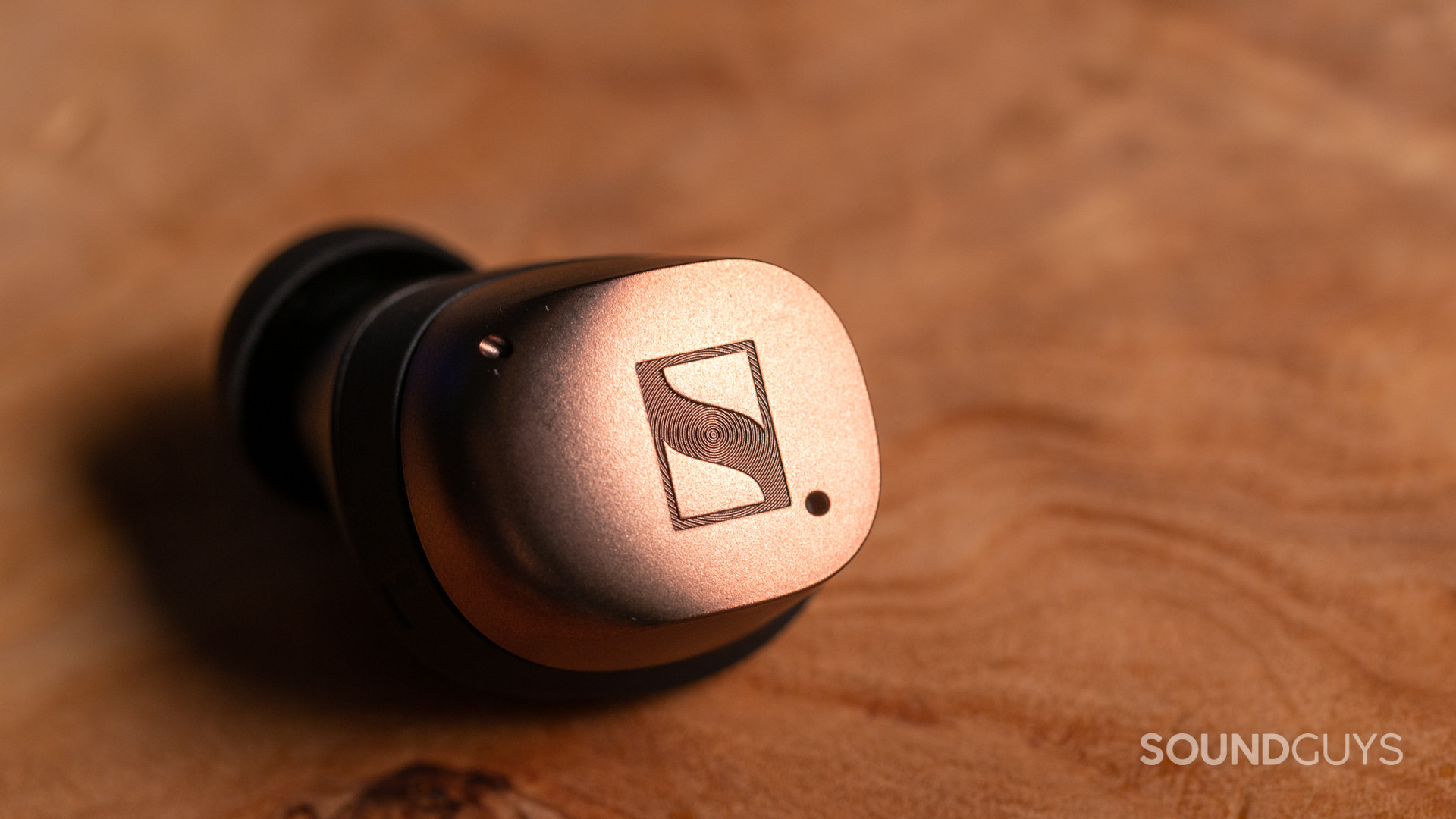
Reasons to Buy:
- Excellent sound quality
- Strong active noise cancelation (ANC) performance
- Support for aptX Lossless and LE Audio
- Comprehensive app with EQ and sound personalization
- Comfortable fit with multiple ear tips and fin options
- Future-proof with Bluetooth 5.4 and Auracast support
Reasons Not to Buy:
- High price point ($299.95)
- Subpar microphone performance, especially in noisy or windy conditions
- Large earbud size may not suit those with smaller ears
- May be overkill for users who don’t need high-end codecs or lossless audio
In the competitive landscape of wireless earbuds, the Sennheiser MOMENTUM True Wireless 4 earbuds stand out as a top recommendation for Android and iOS users alike, offering a blend of premium features, sound quality, and versatility that cater to a wide range of users. They compete directly with our top pick position, currently held by the Sony WF-1000XM5. They make a good argument for taking that crown for those seeking future-proof technology. The only areas in which they fall short compared to the XM5’s are in battery life and microphone quality.
The Momentum True Wireless 4 are a solid contender in the world of ANC earbuds.
Notably, these earbuds support Auracast and LE Audio, two technologies poised to enhance wireless audio experiences soon. Additionally, the inclusion of the aptX Lossless audio codec ensures high-fidelity sound. The earbuds also offer an IP54 rating for resistance against dust and water, wireless charging capabilities, and a commendable ANC performance that effectively reduces environmental noise.
In short, these earbuds have some of the best sound quality and active noise canceling capabilities on the market. They are best suited for people with the money for a top-end product and the infrastructure (a brand-new Android phone, specifically) to fully enjoy higher-bitrate tunes.


Quick Specs
- Battery life: 7 hours and 45 minutes
- Connectivity: Bluetooth 5.4 (SBC, AAC, aptX Adaptive, aptX Lossless, or LC3 and LE Audio)
- Protected against: Water and dust resistant (IP54)
- Weight: 6.2g per earbud
Key Rating Metric
| SoundGuys Rating | 8.5 |
|---|---|
User Rating | 7.7 |
Sound Quality | 9.6 |
Isolation / Attenuation | 7.4 |
Active Noise Cancelling | 8.3 |
Objective Measurements
Loading chart ...
The objective measurements here are relatively close to what we like to see. In the lows, a minor emphasis should make basslines, low vocals, and bass guitar fundamentals easier to hear in the cacophony of a busy mix. However, there’s a high-end underemphasis where we like to see higher levels. Specifically, in the 2-4kHz region, a bit of emphasis is helpful for speech intelligibility and general clarity.
The chart below shows how the sound of the Sennheiser MOMENTUM True Wireless 4 was assessed by the Multi-Dimensional Audio Quality Score (MDAQS) algorithm from HEAD Acoustics.
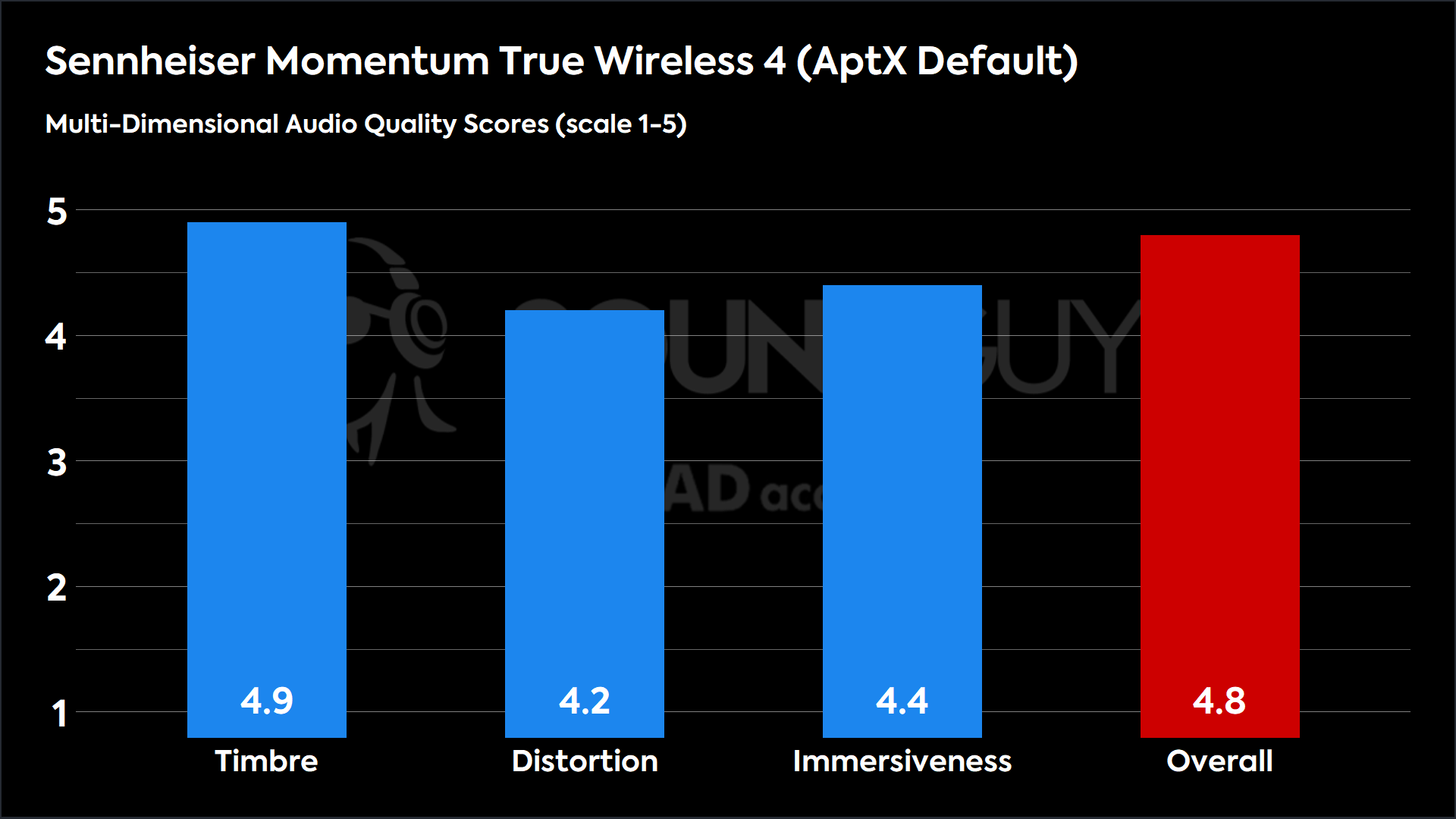
The high immesiveness score is especially good for gaming and movie content, as it allows you to accurately place sound sources in the mix.
Loading chart ...
The Sennheiser MOMENTUM True Wireless 4’s ANC did pretty well in our lab, posting an average noise attenuation of 83%. Getting a good seal has pretty stark benefits for passive isolation, too. In that regard, the MOMENTUM True Wireless 4 does very well, physically blocking almost 50dB in some ranges.
The Sennheiser MOMENTUM True Wireless 4 has a sufficient microphone for phone calls, but the mic performance is below what we’re used to for higher-tiered TWS earbuds. We found the speech quality highly variable, and environmental noise is not suppressed well or consistently.
Sennheiser MOMENTUM True Wireless 4 microphone demo (Ideal conditions):
Sennheiser MOMENTUM True Wireless 4 microphone demo (Office conditions):
Sennheiser MOMENTUM True Wireless 4 microphone demo (Street conditions):
Sennheiser MOMENTUM True Wireless 4 microphone demo (Windy conditions):
Best wireless earbuds for working out or running: Jabra Elite 8 Active Gen 2
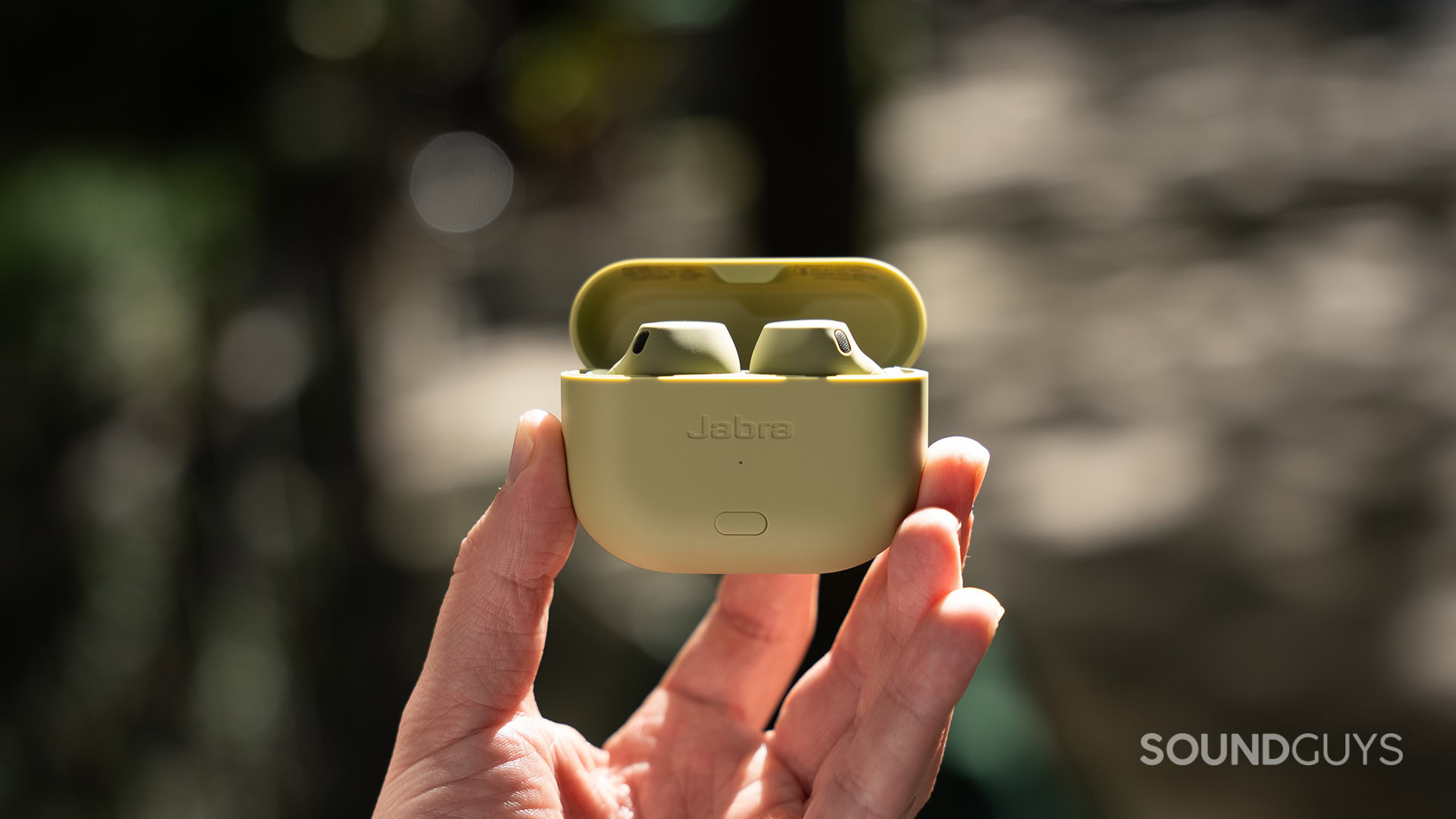
Reasons to Buy:
- Excellent durability
- Strong active noise cancelation
- Good sound quality
- Case can connect to wired sources
- Comprehensive app with extensive customization options
- Spatial audio support
- Good microphone performance in various environments
Reasons Not to Buy:
- Uncertain future for software updates
- Lack of wing tips or hooks for extra secure fit during intense workouts
- Default sound profile may lack emphasis in high frequencies
- Limited codec support (SBC and AAC only)
- No onboard storage for swimming use
The Jabra Elite 8 Active Gen 2 stands out as the premier choice for fitness enthusiasts seeking durable, feature-packed earbuds. These earbuds excel in both form and function, offering exceptional durability with an IP68 rating for the earbuds and IP54 for the case. The ShakeGrip coating ensures they stay put during intense workouts, while the comfortable design allows for extended wear.
The Jabra Elite 8 Active Gen 2 are excellent workout earbuds
Sound quality is impressive, with a bass-forward profile ideal for motivating workouts. The Active Noise Cancellation (ANC) effectively blocks out gym noise, reducing most environmental sounds by 80%. For outdoor runners, the adjustable HearThrough mode keeps you aware of your surroundings. The accompanying Jabra Sound+ app offers extensive customization options, including EQ adjustments and control customization.
A standout feature is the smart case’s ability to connect to wired sources, making these earbuds versatile beyond just workouts. With Bluetooth 5.3, multipoint connectivity, and Dolby Spatial Sound support, the Jabra Elite 8 Active Gen 2 offers a premium audio experience for both exercise and everyday use.


Quick Specs
- Battery life: 9 hours 3 minutes
- Connectivity: Bluetooth 5.3 (SBC, AAC). The charging case can also be used as a transmitter to connect to wired sources via 3.5mm or USB-C.
- Water resistance: IP68 (earbuds), IP54 (case)
- Weight: 5g per earbud
Key Rating Metrics
| SoundGuys Rating | 8.6 |
|---|---|
User Rating | 6.7 |
Sound Quality | 9.6 |
Isolation / Attenuation | 7.0 |
Active Noise Cancelling | 8.1 |
Objective Measurements
Loading chart ...
As you can see, the earbuds under-emphasize low-mid frequencies from 200-500Hz compared to our target, which makes some vocals and pianos sound quieter than you might expect. There is also an under-emphasis in the high frequencies above 8kHz, and a relative over-emphasis in the sub-bass below 100Hz.
The chart below shows how the sound of the Jabra Elite 8 Active Gen 2 was assessed by the Multi-Dimensional Audio Quality Score (MDAQS) algorithm from HEAD acoustics.
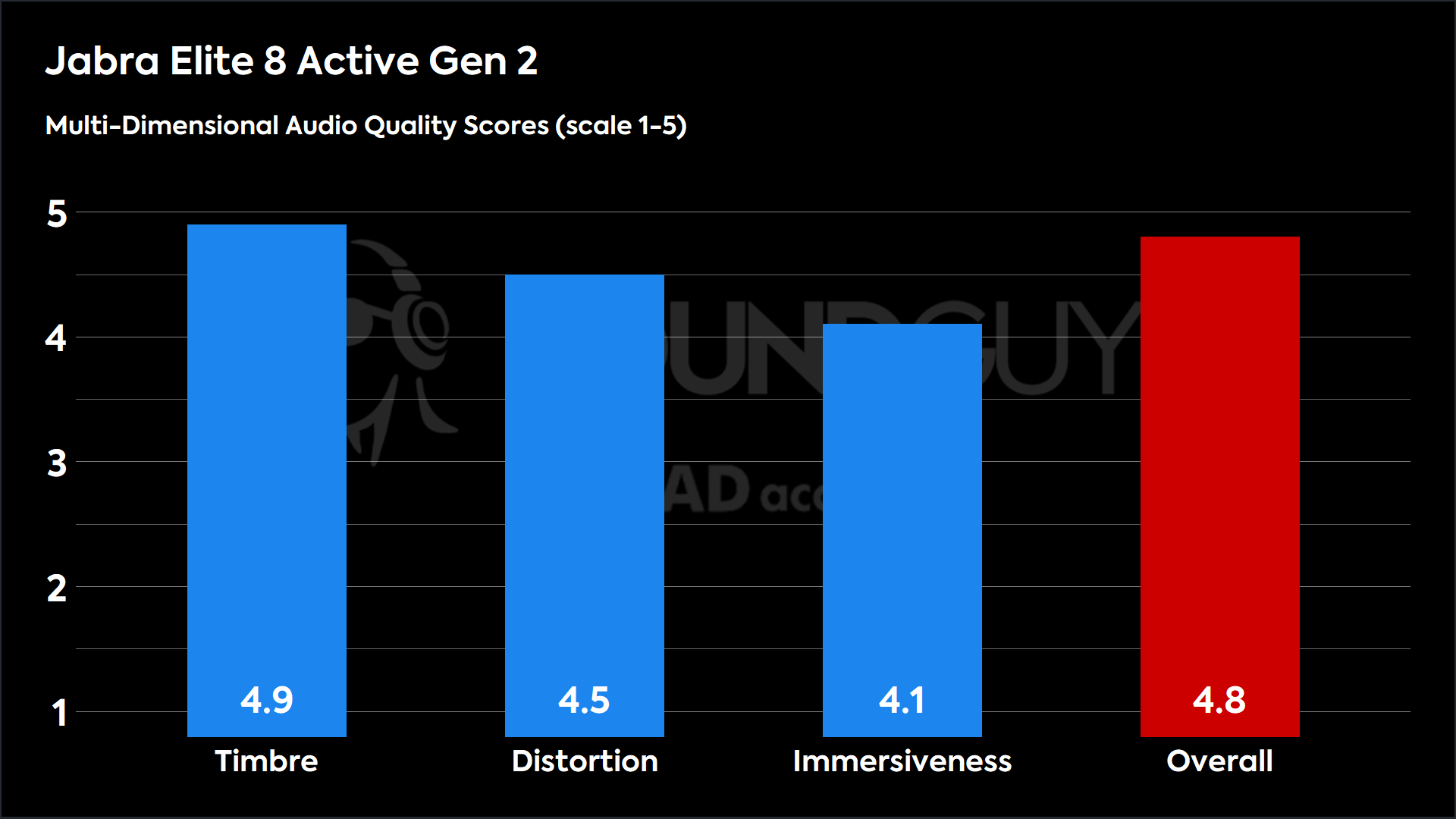
A simulated panel of listeners rates the default sound of the Jabra Elite 8 Active Gen 2 very highly, with a near-perfect rating in Timbre. Across Distortion and Immersiveness the earbuds also score well, leading to one of the highest Overall scores among wireless earbuds.
Loading chart ...
The Jabra Elite 8 Active Gen 2 have great noise canceling, though not quite as good as the Elite 10 Gen 2. Most environmental noise is reduced by 80%, with low-frequency noise below 100Hz attenuated by about 30 dB.
The Elite 8 Active Gen 2 is up for the task with six onboard microphones. In both quiet and loud environments, the microphones focus on your voice, so the person on the other end of the line shouldn’t have a problem hearing you.
Jabra Elite 8 Active Gen 2 microphone demo (Ideal conditions):
Jabra Elite 8 Active Gen 2 microphone demo (Office conditions):
Jabra Elite 8 Active Gen 2 microphone demo (Street conditions):
Jabra Elite 8 Active Gen 2 microphone demo (Windy conditions):
Best wireless earbuds for bass: Bose QuietComfort Ultra
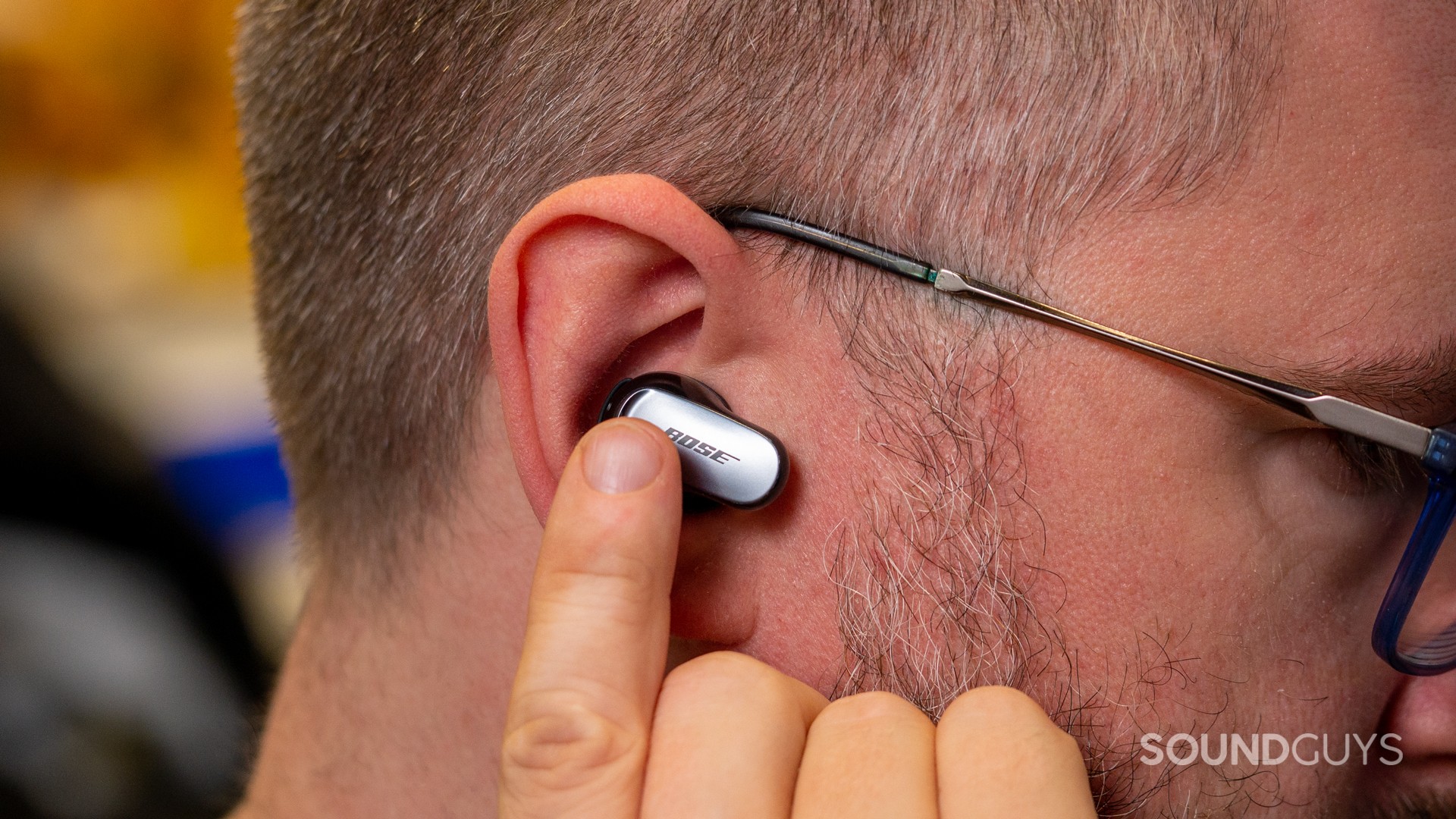
Reasons to Buy:
- Excellent active noise cancelation
- Comfortable fit with ovoid-shaped nozzles
- Support for Snapdragon Sound with aptX Lossless and aptX Adaptive
- Immersive Audio with head-tracking
- Touch controls that don’t compromise ear seal
Reasons Not to Buy:
- High price point ($299)
- Limited EQ options in the app
- Chunky charging case
- Microphone performance is inconsistent across different environments
- No LE Audio support
- Overkill for iPhone users
If you find the typical cylindrical nozzle of earbuds uncomfortable, the Bose QuietComfort Ultra Earbuds, as the name suggests, offer a more comfortable alternative design. They may be chunky, but they feature an egg-shaped nozzle that sits more firmly in your ears. The sliding touch controls are more intuitive and avoid tapping gestures that can tend to push earbuds deeper into sensitive ear canals.
If you own a newer Android device, you may benefit from the revamped chipset of these earbuds. Namely, they offer Snapdragon Sound with aptX Lossless support, which purportedly provides Hi-Res audio using aptX Adaptive. This feature also allows low-latency listening and Google Fast Pair for source devices with a compatible processor. However, regardless of your device, you are going to need to install the Bose Music app in order to enjoy features like Immersive Audio, in-app EQ, firmware updates, and customizing the shortcut gesture.
If you’re using a new Android phone, the Bose QuietComfort Ultra Earbuds are unquestionably among the top options at this price point.
The Bose QuietComfort Ultra earbuds have some of the best ANC we’ve ever tested, silencing outside sounds under 400Hz by up to 34 dB. Soundwise, these earbuds will appeal to a specific type of listener: someone who wants strong bass and treble. If you like music that suits that profile, this shouldn’t be a problem – it’s just not for everyone, and too much low-end may rattle your skull.

Quick Specs
- Battery life: 6 hours and 11 minutes
- Connectivity: Bluetooth 5.3 (SBC, AAC, aptX Adaptive, and Snapdragon Sound. LE Audio)
- Protected against: Water resistant (IPX4)
- Weight: 7.1g per earbud
Key Rating Metric
| SoundGuys Rating | 7.3 |
|---|---|
User Rating | 8.0 |
Sound Quality | 8.8 |
Isolation / Attenuation | 3.8 |
Active Noise Cancelling | 8.4 |
Objective Measurements
Loading chart ...
Compared to our headphone preference curve, the Bose QuietComfort Ultra Earbuds have a strong overemphasis in both the bass and treble regions. They peak at 14dB around 30Hz, which is about 10dB more than we would like to see in the low-end, and again around 2,500Hz.
The chart below shows how the sound of the Bose QuietComfort Ultra Earbuds was assessed by the Multi-Dimensional Audio Quality Score (MDAQS) algorithm from HEAD Acoustics.
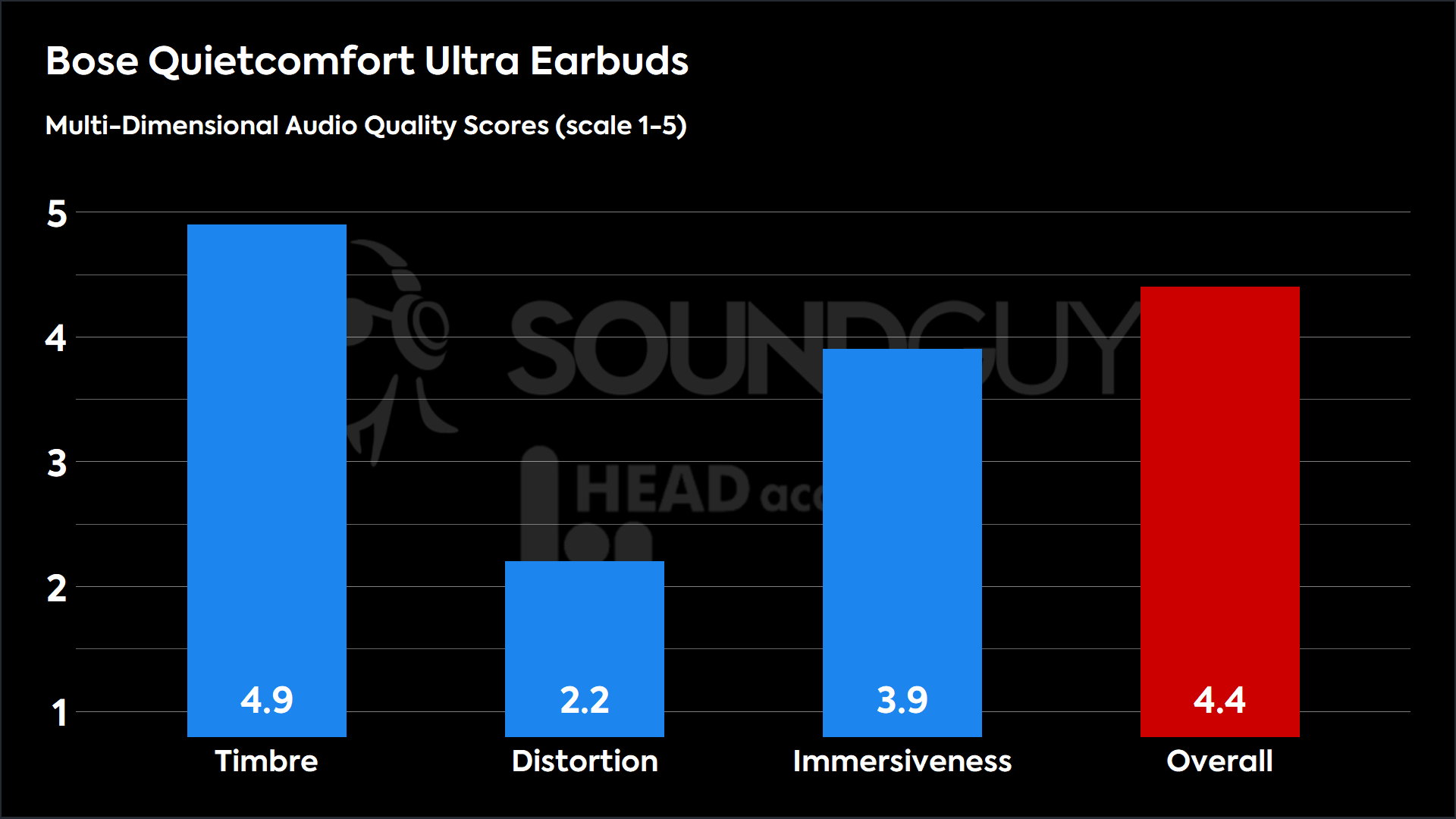
With an overall score of 4.4, the Bose QuietComfort Ultra Earbuds have the average sound quality you would expect from flagship wireless earbuds. However, the Distortion and Immersiveness are a tad lower than we would expect for the price.
Loading chart ...
The Bose QuietComfort Ultra Earbuds have some of the best ANC we’ve measured. Despite a little dip in the mids, the Bose QC Ultra Earbuds quell outside noise under 400Hz by up to 34dB — effectively reducing the perceived loudness by around 90%. Additionally, the Bose QCt Ultra Earbuds can silence noise above 1kHz by up to 39dB, which is outstanding.
The Bose QuietComfort Ultra Earbuds have a microphone array that performs well enough for phone calls. Listen to the standardized samples below to hear how well the microphone performs in several common settings.
Bose QuietComfort Ultra Earbuds microphone demo (Ideal conditions):
Bose QuietComfort Ultra Earbuds microphone demo (Office conditions):
Bose QuietComfort Ultra Earbuds microphone demo (Street conditions):
Bose QuietComfort Ultra Earbuds microphone demo (Windy conditions):
Bose QuietComfort Ultra Earbuds
The best wireless earbuds: Notable mentions
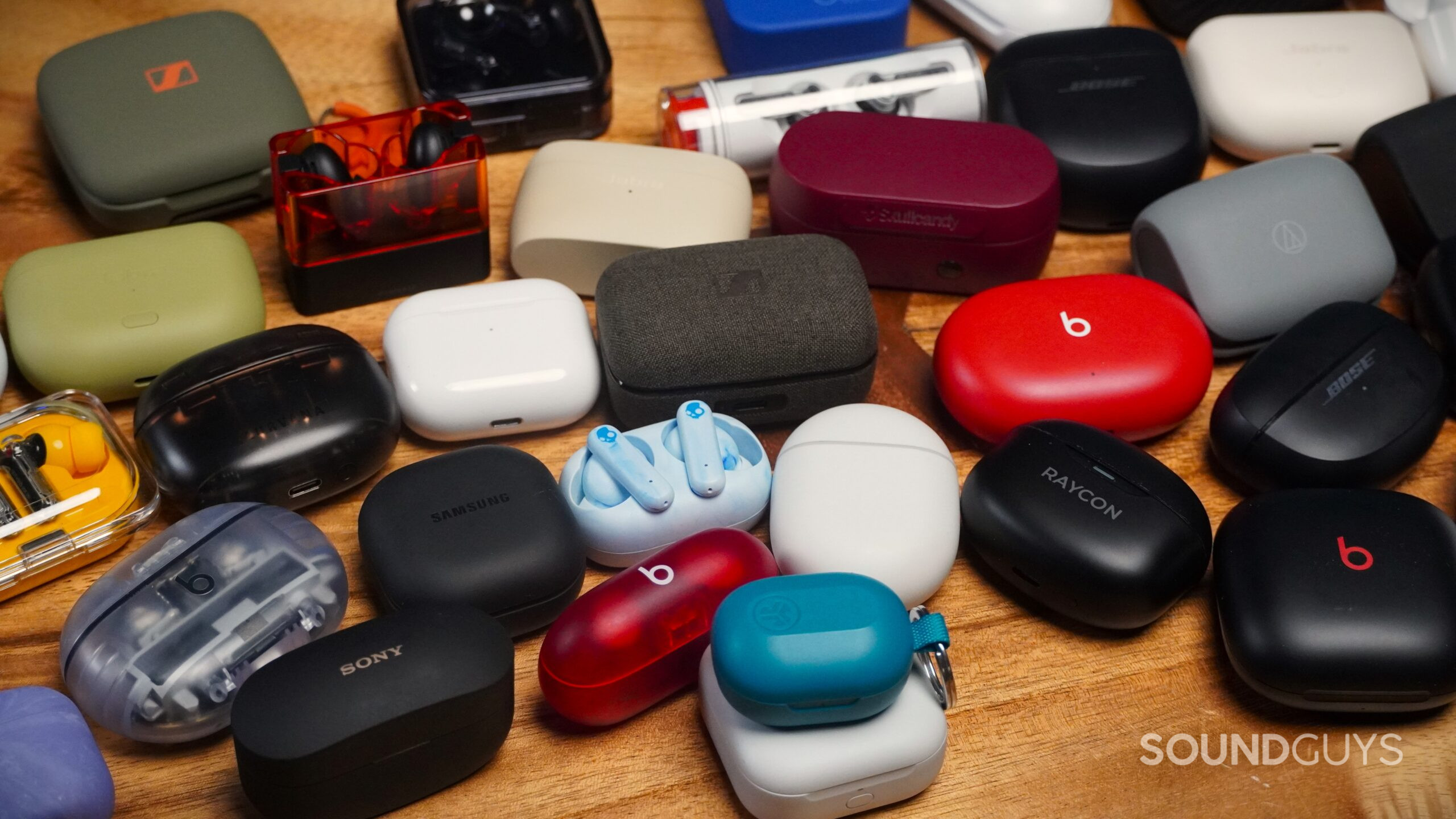
- Anker Soundcore Liberty 4 NC ($99.99 at Amazon): These are definitely a contender for some of the best affordable noise canceling earbuds based on performance and value. With an IPX4 rating, long battery life, and good ANC, these are worth a go. You might not want to go for a run with them, but otherwise, they’re decent.
- Apple AirPods 4 ($129 at Amazon): The AirPods 4 are a noticeable upgrade over their predecessors. If possible, try them on before buying, as your experience will be heavily dependent on whether or not the new shape of the AirPods fits your ears.
- Apple Airpods 4 with ANC ($179.99 at Amazon): The Apple AirPods 4 with Active Noise Cancellation is a great effort to bring ANC to unsealed AirPods — though it’s still not everyone’s cup of tea. AirPods fans will love the new earbuds, though newcomers might not understand the hype.
- Audio-Technica ATH-TWX7 ($194.5 at Amazon): The mid-range offering from Audio-Technica has a short battery life, but otherwise, the ATH-TWX7 are a solid set of earbuds. These are a worthy buy if you are looking for a secure fit with good noise canceling.
- Beats Studio Buds Plus ($99.95 at Amazon): The Beats Studio Buds Plus are a competent, if slightly understated true wireless option for those who don’t want the AirPods Pro. Additionally, this Apple-owned product offers an alternative to the lollipop design of the AirPods earphones.
- Bowers & Wilkins Pi8 ($399 at Amazon): The Bowers & Wilkins Pi8 are luxury earbuds that cost a pretty penny. If you want great sound quality and noise canceling wrapped in a luxury finish, these earbuds might be for you.
- Bose QuietComfort Earbuds ($179 at Amazon): These earbuds deliver excellent sound quality and noise canceling at an affordable price. The only thing holding us back from a stronger recommendation is the connectivity issues we experienced while testing them.
- Creative Aurvana Ace 2 ($149.99 at Amazon): If you are in the market for the best-sounding wireless earbuds, consider the Creative Aurvana Ace 2. The xMEMS driver system sounds excellent, and you can customize the sound using the Creative app. Combined with aptX Lossless support, these earbuds will pique the interest of many audiophiles.
- CMF Buds Pro 2 (on the product's website): The CMF Buds Pro 2 punch well above their price point, offering solid sound quality and impressive ANC, with the innovative Smart Dial being the unexpected star of the show.
- EarFun Free Pro 3 ($79.99 at Amazon): These are surprisingly decent entry-level wireless earbuds, especially in terms of their sound quality. The app is mature, and the price is very reasonable.
- Google Pixel Buds Pro 2($229 at Amazon): These are an excellent Pixel phone companion, offering a slew of useful improvements and features that the original Pixel Buds Pro do not. Though the new tuning might not satisfy bassheads, the EQ presets are good enough to handle just about any preference. Many people will love these earbuds.
- JLab Epic Lab Edition ($199.99 at Amazon): The JLab Epic Lab Edition are the testbed for the latest generation of Knowles balanced armature drivers, and they make a compelling case. Great sound quality paired with most of the top-flight features we expect from high-end earbuds make this one of the best buys in the category.
- JLab Epic Air Sport ANC ($89 at Amazon): This set of buds directly competes against the Beats Powerbeats Pro and costs a heck of a lot less. You get pretty good ANC for the price, and a consumer-friendly sound profile that you can change with the earbuds’ built-in EQ presets.
- Moondrop Space Travel ($24.99 at Amazon): If you’re looking for bang for your buck, it’s hard to do better than these earbuds. Though they don’t have much in the way of software features, the Moondrop Space Travel offers excellent audio quality and ANC for under $30.
- Master & Dynamic MW09 ($349 at Amazon): Exceptional battery life and premium materials mean the Master & Dynamic MW09 is built to last a long time. You have to pay a pretty penny for these earbuds, but you’ll turn a few heads with the eye-catching design.
- Nothing Ear (a) ($95 at Amazon): If you have $100 to spend on earbuds, the Nothing Ear (a) are a good option. These jack-of-all-trades earbuds don’t excel in any particular way but also don’t have any major drawbacks.
- Panasonic Technics EAH-AZ80 ($417 at Manufacturer site): Though they’re quite large earbuds, the Technics EAH-AZ80 are very solid performers, with a rock-solid array of features to boot. Though the sound might not be for everyone, we believe most should really like these earbuds, even if they aren’t the consensus best-ever.
- SoundPEATS Capsule3 Pro+ ($89.99 at Amazon): The SoundPEATS Capsule3 Pro+ have xMEMS drivers that deliver exceptional sound quality, at a price that doesn’t break the bank.
- Sennheiser MOMENTUM Sport ($329 at Amazon): If you want biometric tracking built into your earbuds, the Sennheiser MOMENTUM Sport is the best option.
- Sony LinkBuds S ($148 at Amazon): Unlike the standard LinkBuds, the LinkBuds S features a traditional earbud design without donut holes. Noise canceling performance is close to the WF-1000XM4 and outperforms the previous Sony WF-1000XM3 flagship earbuds.
Take SoundGuys’ quiz to find your best fit
How we test wireless earbuds
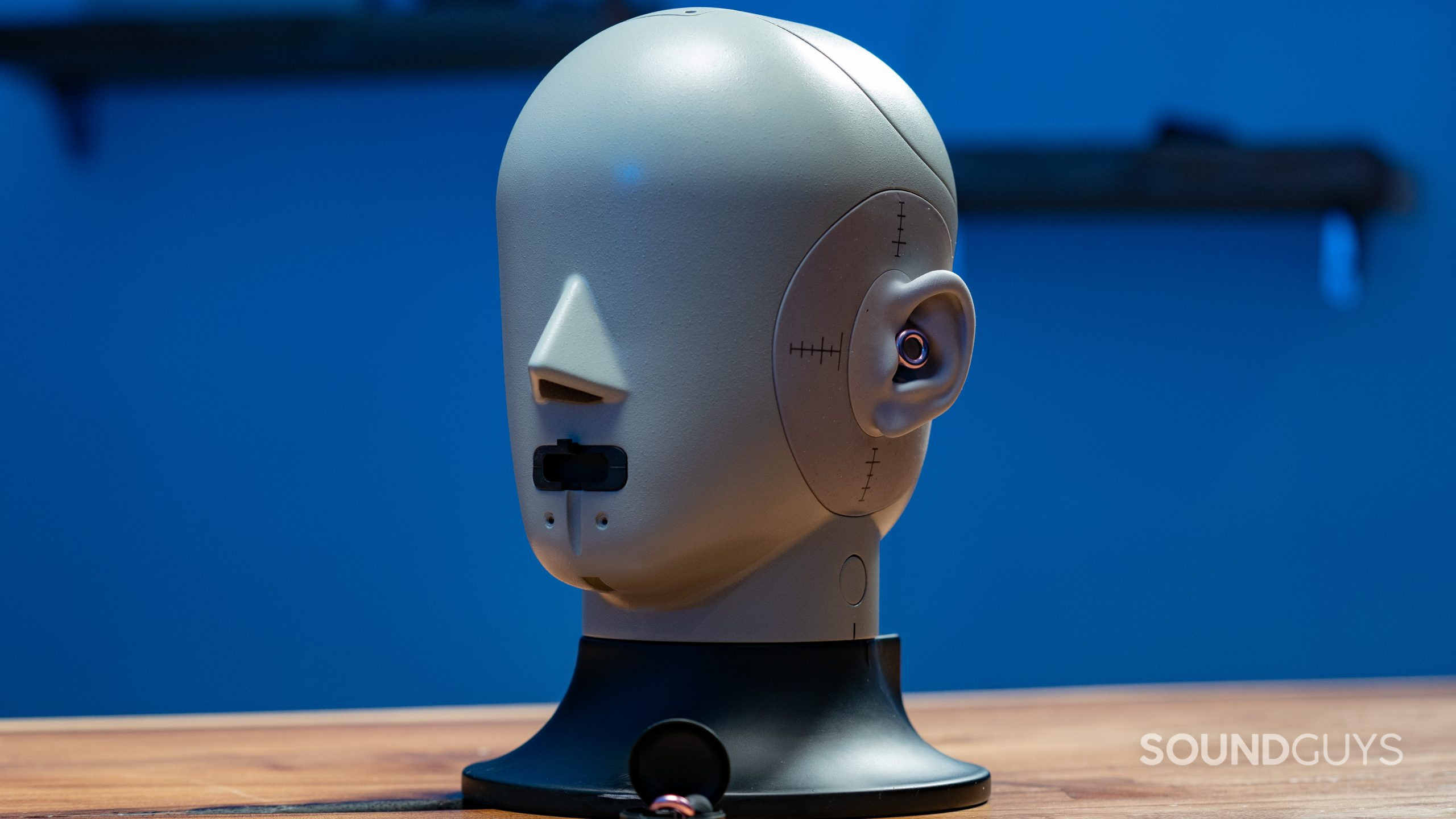
Using a dummy head, product designers can test out how audio products will perform for most people — and so do we. We run a number of tests, including frequency response, isolation, and battery life. You can read more about it here and learn more about the specifics.
- For each product, we played several sine sweeps through the earphones. Once we arrived at a representative result, we logged the frequency response, demonstrating the hallmarks of a good acoustic seal.
- To test isolation, we play a sample of shaped noise at 90dB(SPL) (measured at the eardrum), once with the headphones off and another with the headphones on. We then subtract one measurement from the other.
- To test the battery, we use shaped noise and a real-time analyzer to find the setting needed to output consistent audio peaking at 75dB(SPL) from the products. We play our music test track on an infinite loop. This means every result can be directly compared.
These three basic tests cover the biggest areas of concern with wireless earbuds. Remember that your battery life will vary if you tend to crank the volume. Additionally, you could squeak out better isolation performance if you use third-party tips on your earbuds.
We try to get as much hands-on time with products as possible before declaring them one of the best. This means that the products on this list have been put through our full review process. We also spend hours browsing through forums and discussions within the audio community. Even if we’ve already reviewed a product, we do this to get as much of a birds-eye view of the landscape as possible.
Why you should trust SoundGuys
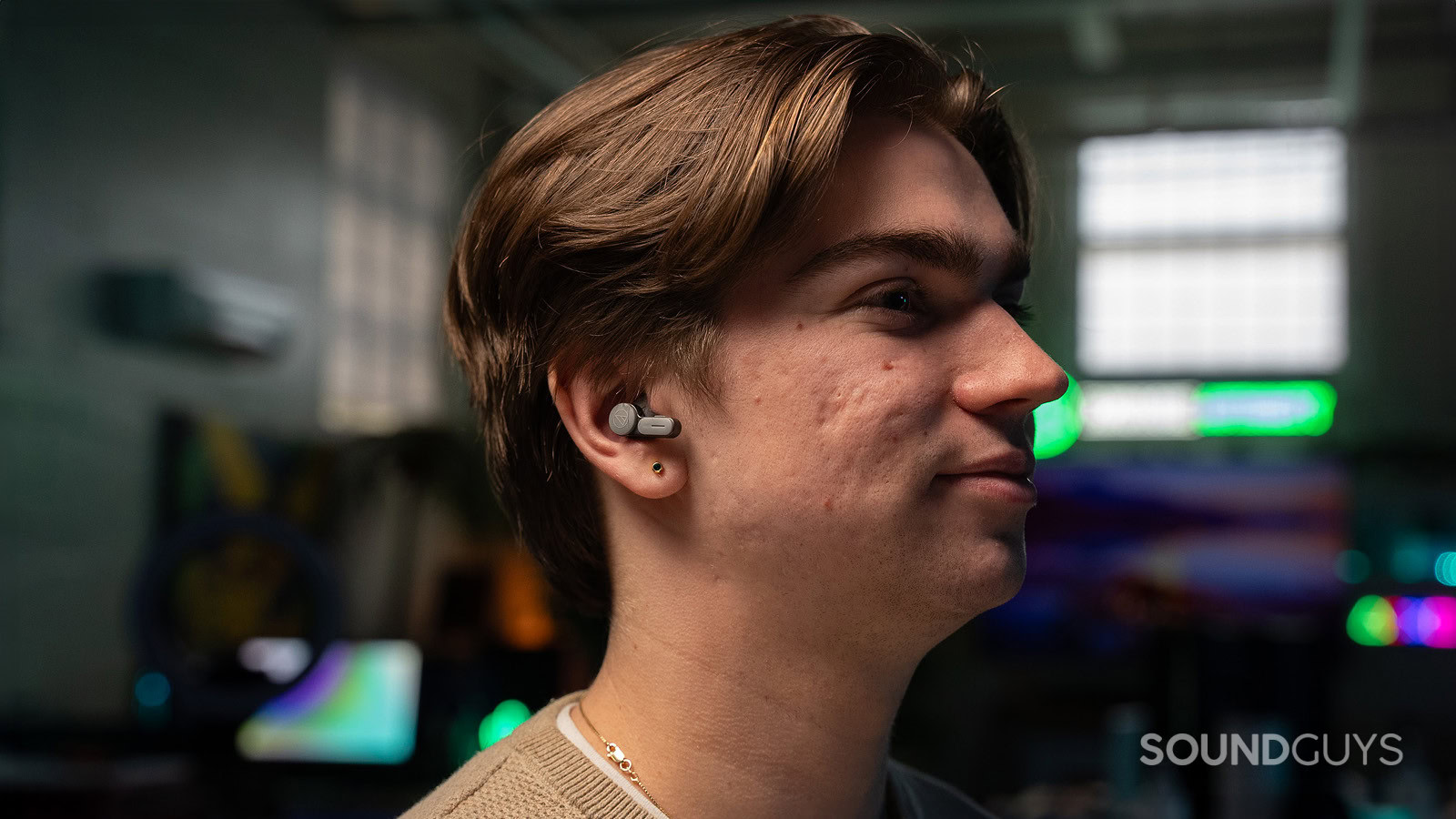
We’ve had our finger on the pulse of wireless earbuds since they hit the market. We pride ourselves on our ability to show our work and justify why we selected our picks. SoundGuys takes integrity very seriously.
Everything we recommend results from our objective measurements and great subjective experiences. Ultimately, we want you to enjoy your purchase or, at the very least, leave our site with a little more knowledge about the inner workings of audio.
- February 5, 2025: We ensured the timeliness of the information within the article for the new year.
- December 11, 2024: We added the SoundPEATS Capsule3 Pro+ as a notable mention to our list of best earbuds.
- November 19, 2024: We added a video showing our top earbuds of 2024.
- Nov 5, 2024: We removed the Jabra Elite 7 Active as a notable mention and added the Bowers & Wilkins Pi8.
- October 3, 2024: We added the JBL Tour Pro 3 as the best features pick, the Anker Soundcore Liberty 4 Pro as our pick for the best under $130, and added more notable mentions worth considering.
- August 28, 2024: We added the EarFun AirPro 4 as the new top pick for earbuds under $100. We moved the previous top pick in this category, the Anker Soundcore Liberty 4 NC, to the notable mentions.
- August 9, 2024: We added reasons to buy and reasons not to buy for each top pick, Key Rating Metrics, an expanded introduction, and new images to the article.
- July 8, 2024: We added the Jabra Elite 10 Active as the new top pick for best noise canceling wireless earbuds.
Frequently asked questions
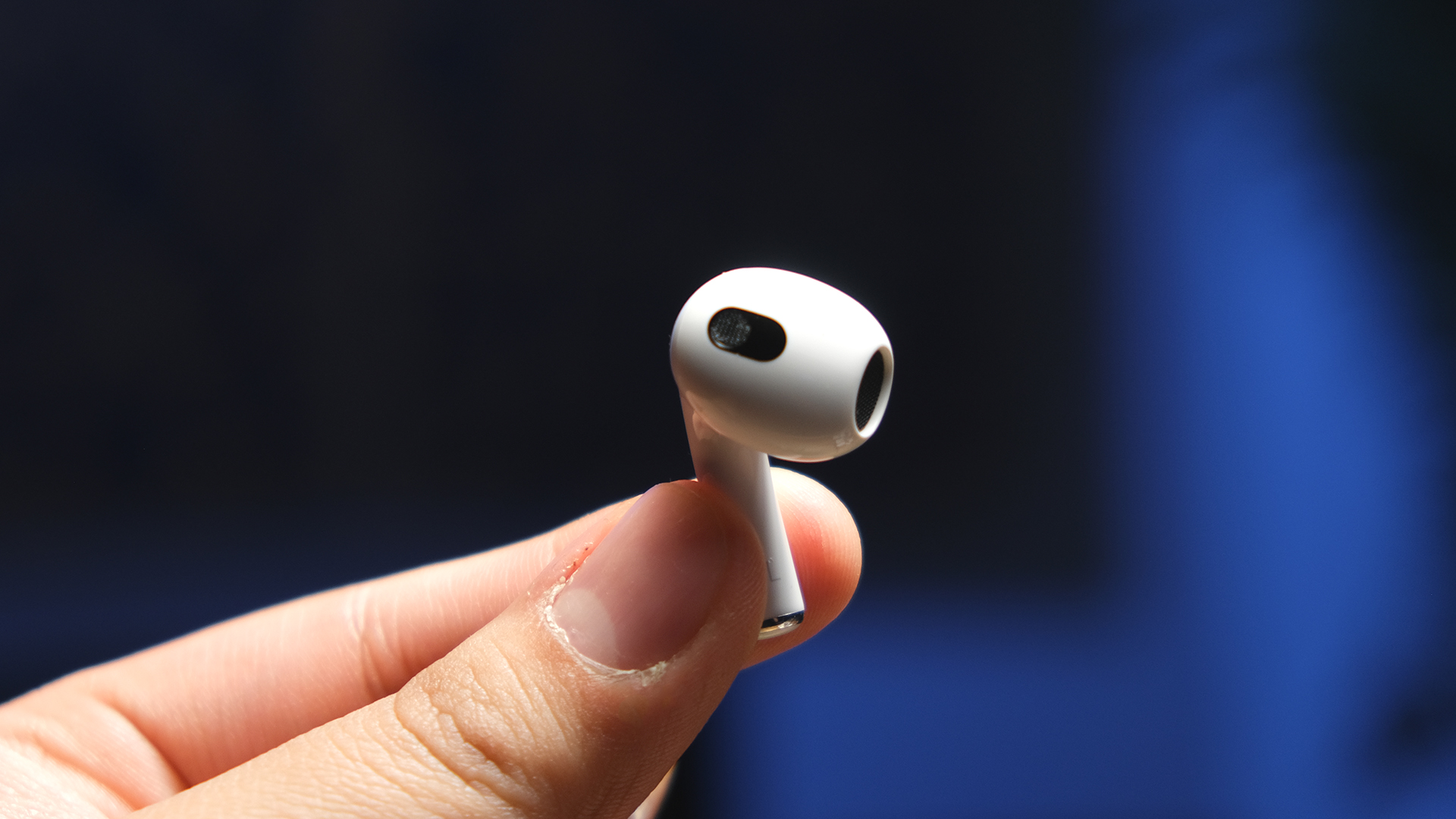
We’re witnessing a wireless epoch. It’s no longer niche or novel to listen completely untethered on your way to work. Technological advancements have lowered the financial barrier to entry, and cheap wireless options are readily available to budget listeners.
Wireless earbuds can still be for you if you don’t commute, especially if you like to exercise. Nothing’s more convenient than listening completely wire-free. There are many great wireless workout earbuds for runners and gym rats alike. Numerous companies have gone the extra mile by getting products officially IP certified, but they also integrate useful athletic features (e.g., ear hook design, silicone wing tips, Ambient Aware mode).
While it’s true that battery depletion is a problem, resulting in a shortened lifetime of wireless earbuds compared to their on-ear or over-ear headphone alternatives, you’re paying a premium for convenience. For some of us, it’s easy to justify the cost. Others may be better off with wired earbuds or dealing with bulkier wireless headphones.
Bluetooth Multipoint is a convenient feature that allows compatible headphones and earbuds to maintain simultaneous connections to multiple devices. This means you can seamlessly switch your audio source between, say, your laptop and smartphone without manually disconnecting from one before connecting to the other.
All the products highlighted in this article support Bluetooth Multipoint connectivity, enabling you to take calls on your phone while listening to music on your computer or easily switch between devices. Some top Bluetooth Multipoint options include the Sony WH-1000XM5 headphones, Bose QuietComfort Ultra, Sennheiser Momentum True Wireless 4 earbuds, and the affordable Anker Soundcore Liberty 4 NC.
While convenient, Bluetooth Multipoint does have some limitations like audio quality constraints when streaming from two sources simultaneously. For a deeper dive into how it works and its pros and cons, check out our full explainer on Bluetooth Multipoint.
Generally speaking, the standalone battery life of wireless earbuds averages anywhere from three to six hours of battery life. Anything that falls above or below that is unusual. The charging cases typically provide an extra two to three charges, giving you at least 9 hours of total playtime.
As far as why battery life is so short on all wireless earbuds, you don’t have to dig too deep into it to get the reason why. Truly wireless earbuds are simply too small. Batteries still rely on physics, and it’s hard to stuff a battery into something so tiny, which is why they all come with cases that will charge up your headphones when they’re not in use. This is pretty bad for the environment, and there aren’t too many eco-friendly headsets to choose from.
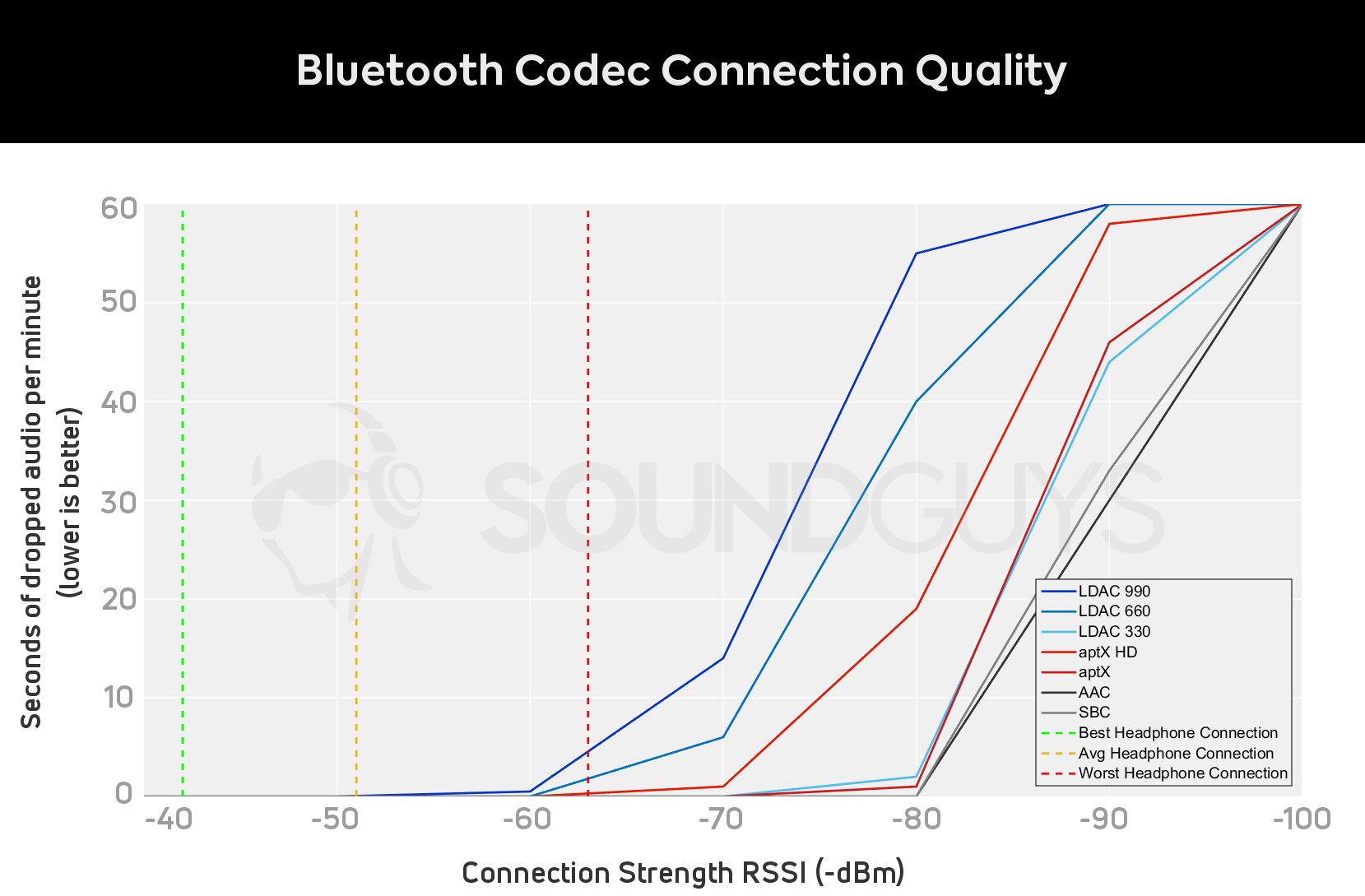
As with any nascent product category, early adopters will need to know a bit more about the tech that defines it. Namely, they need to know what to look for when deciding whether a product will be good or not. With Bluetooth audio, that means figuring out what Bluetooth codecs both their phone and their earbuds support.
As per our investigative testing, LDAC isn’t necessarily Hi-Res. What’s more, AAC is bunk when used on Android devices and should really only be used when listening via iPhone. If your Android phone automatically streams over AAC, you can always force developer settings to mandate SBC streaming instead. Android users, stick to aptX.
No, wireless earbuds use Bluetooth technology for wireless connectivity. Bluetooth is the standard that allows wireless earbuds to connect to devices without cables.
Simply put, no, Raycons are not better than AirPods. In our review, we found the sound quality to be lacking, and there are just too many good and similarly priced true wireless earbuds to make the Raycon Everyday Earbuds worth buying.
A good pair of wireless earbuds typically costs between $100 and $400. This range includes options with high-quality sound, reliable connectivity, and additional features like noise cancelation and water resistance. While there are cheaper alternatives available, they might compromise on sound quality, battery life, or durability. Investing at least $100 or more will generally ensure a balance between performance and value.
In terms of product lifespan, most wireless earbuds generally do not last more than three or four years, primarily due to battery degradation. Over time, these batteries lose their ability to hold a charge, leading to reduced playback time and eventually making the earbuds unusable. While some models might offer slightly better longevity due to the build quality, the small form factor inherently restricts their overall lifespan. To maximize the lifespan of wireless earbuds, it’s important to follow best practices for battery care, such as not exposing them to extreme temperatures and avoiding letting the battery fully deplete regularly.
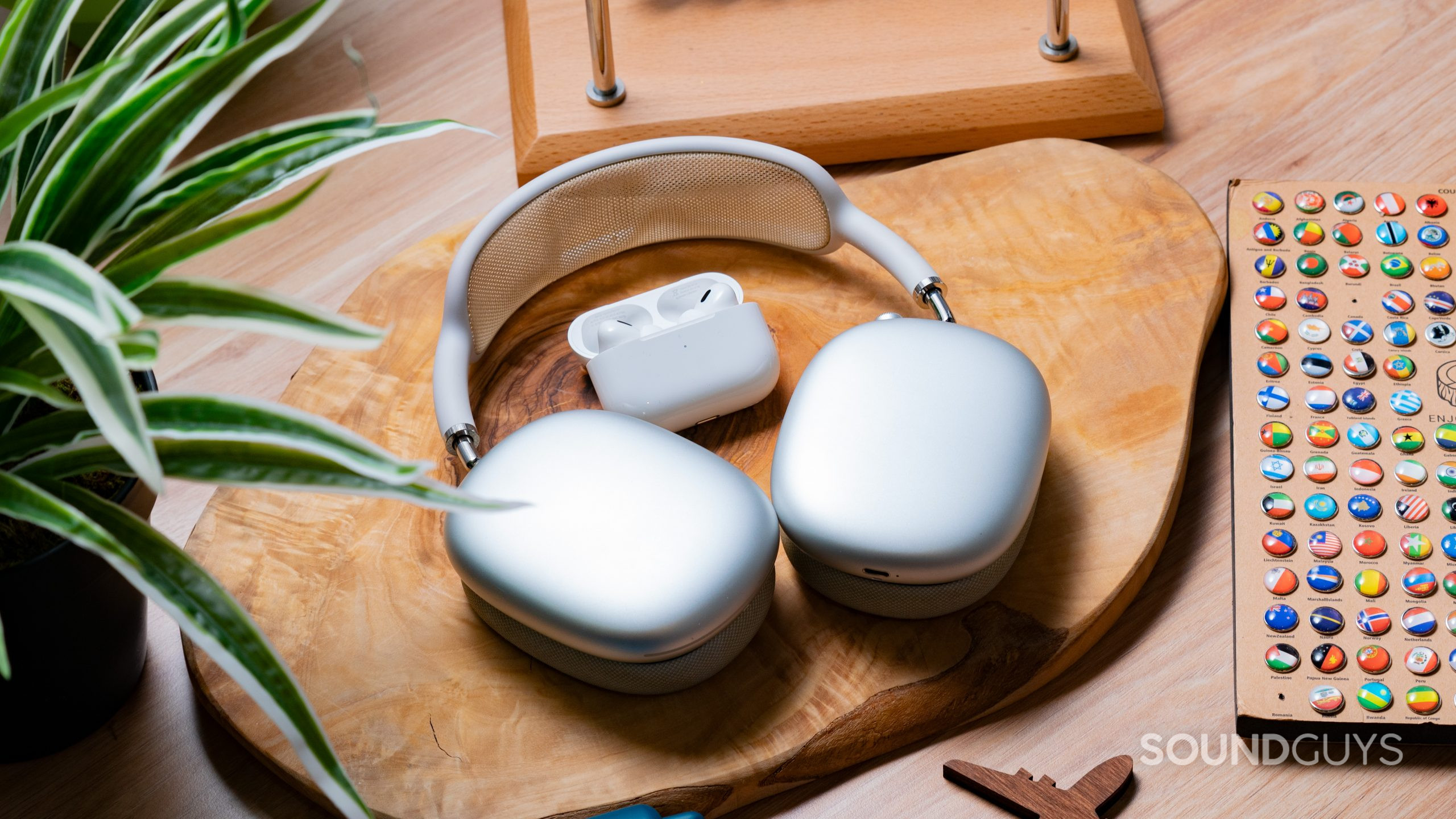
We have an entire article detailing the lifespan of true wireless earbuds’ batteries (spoiler: wireless earbud batteries only last a couple of years with daily use). Wireless headphone batteries are much larger, so you don’t need to charge them as frequently. Since you’re not subjecting wireless headphone batteries to the same daily charge-and-deplete cycle that you do with wireless earbuds, they degrade much slower. In other words, wireless headphone batteries last significantly longer than their wireless in-ear counterparts.
Wireless headphones usually have the added advantage of wired playback. This means that even when the battery fully degrades, you can still connect it to your device’s headphone jack and audio media playback.